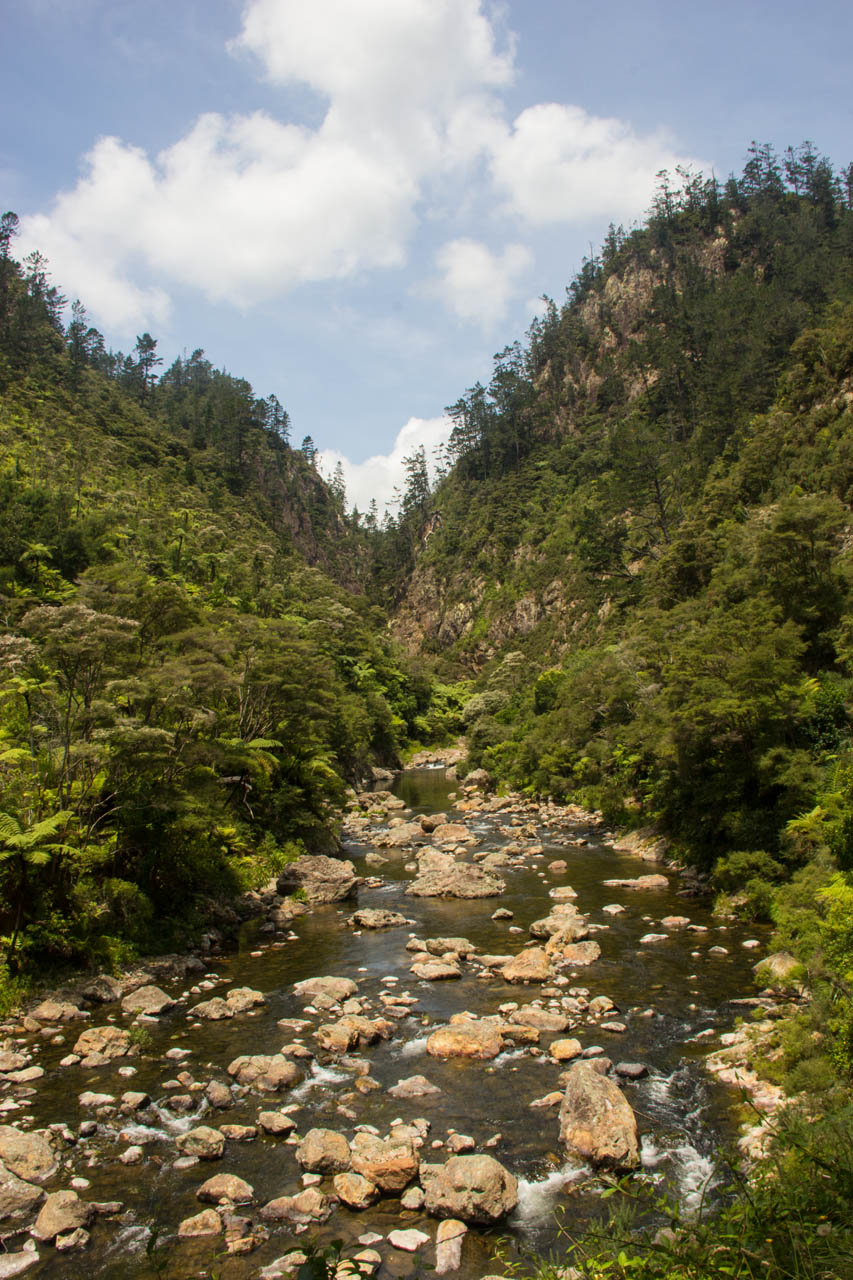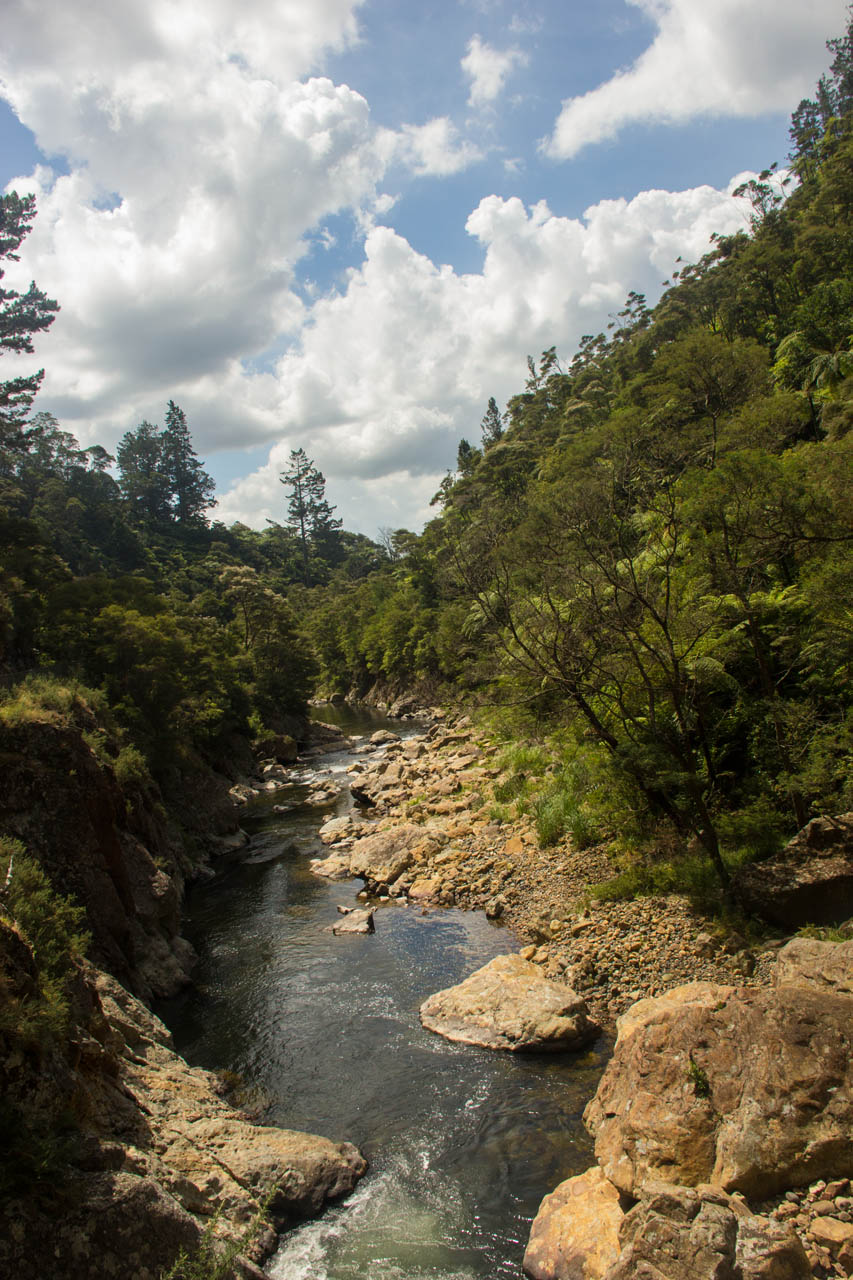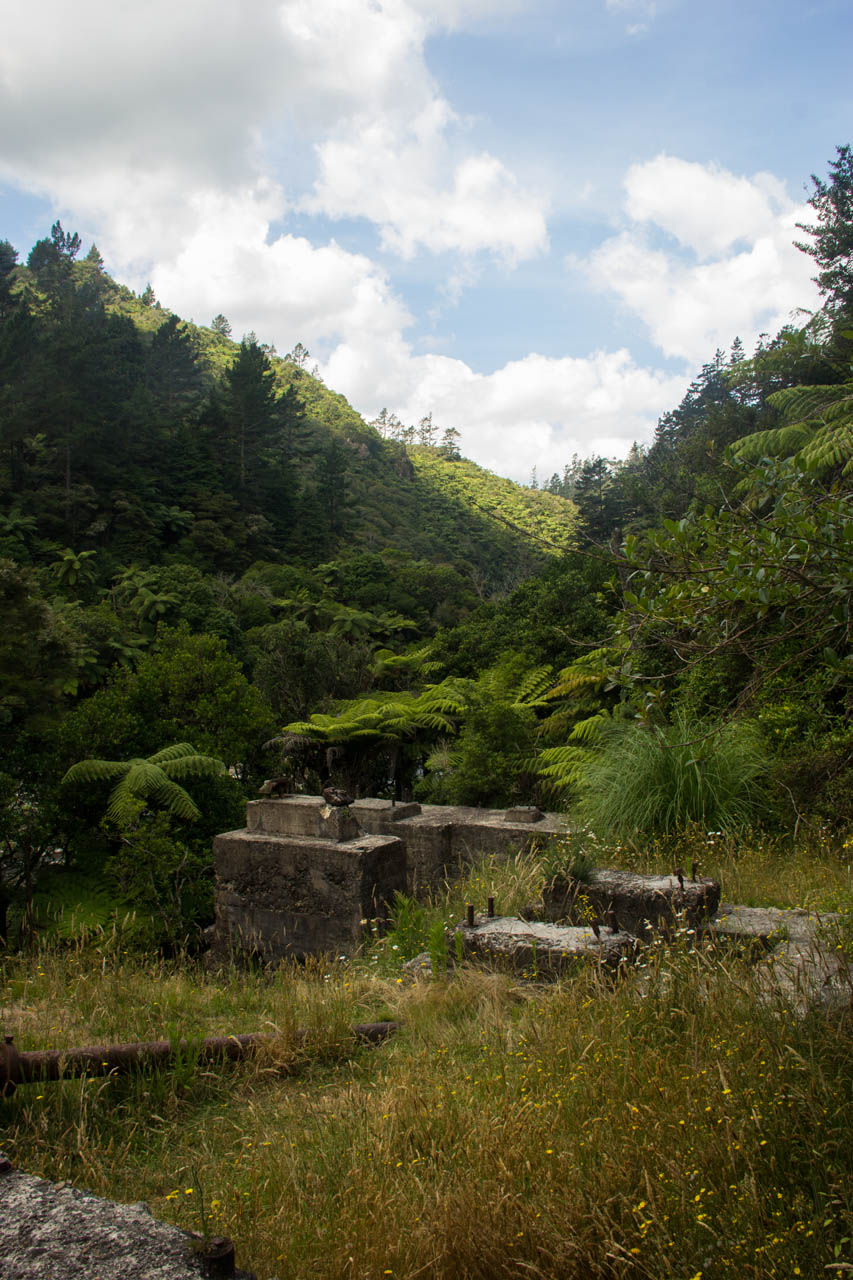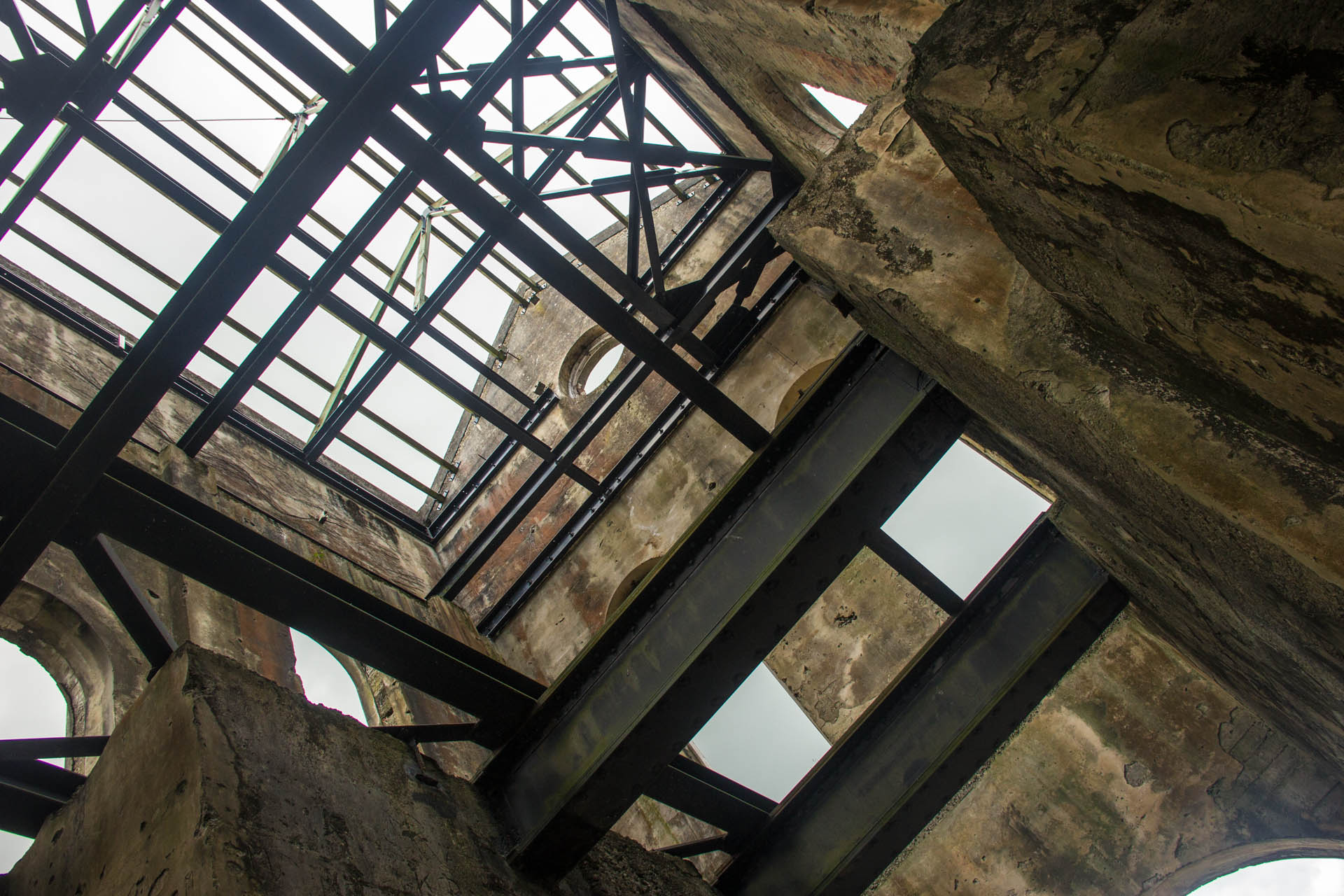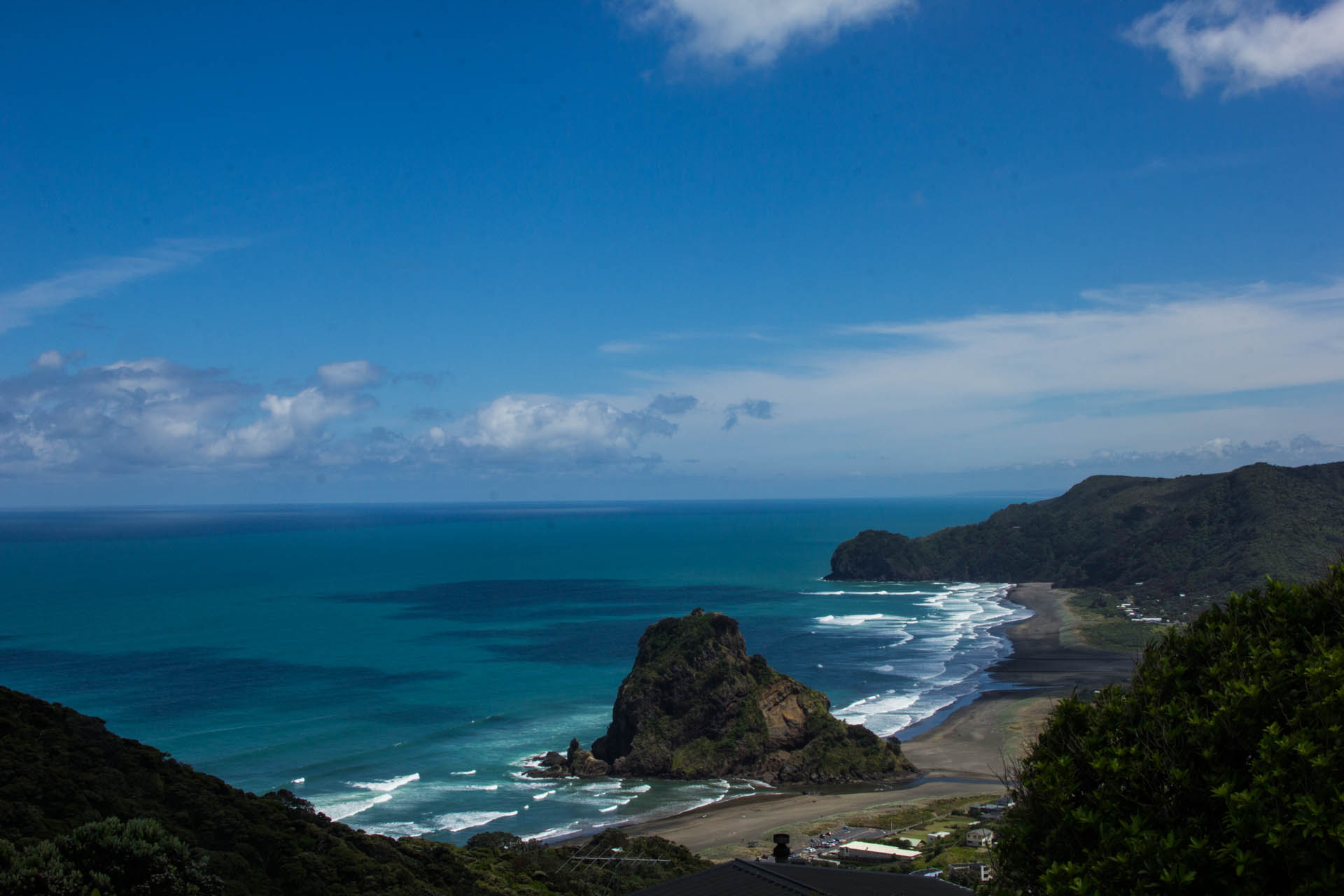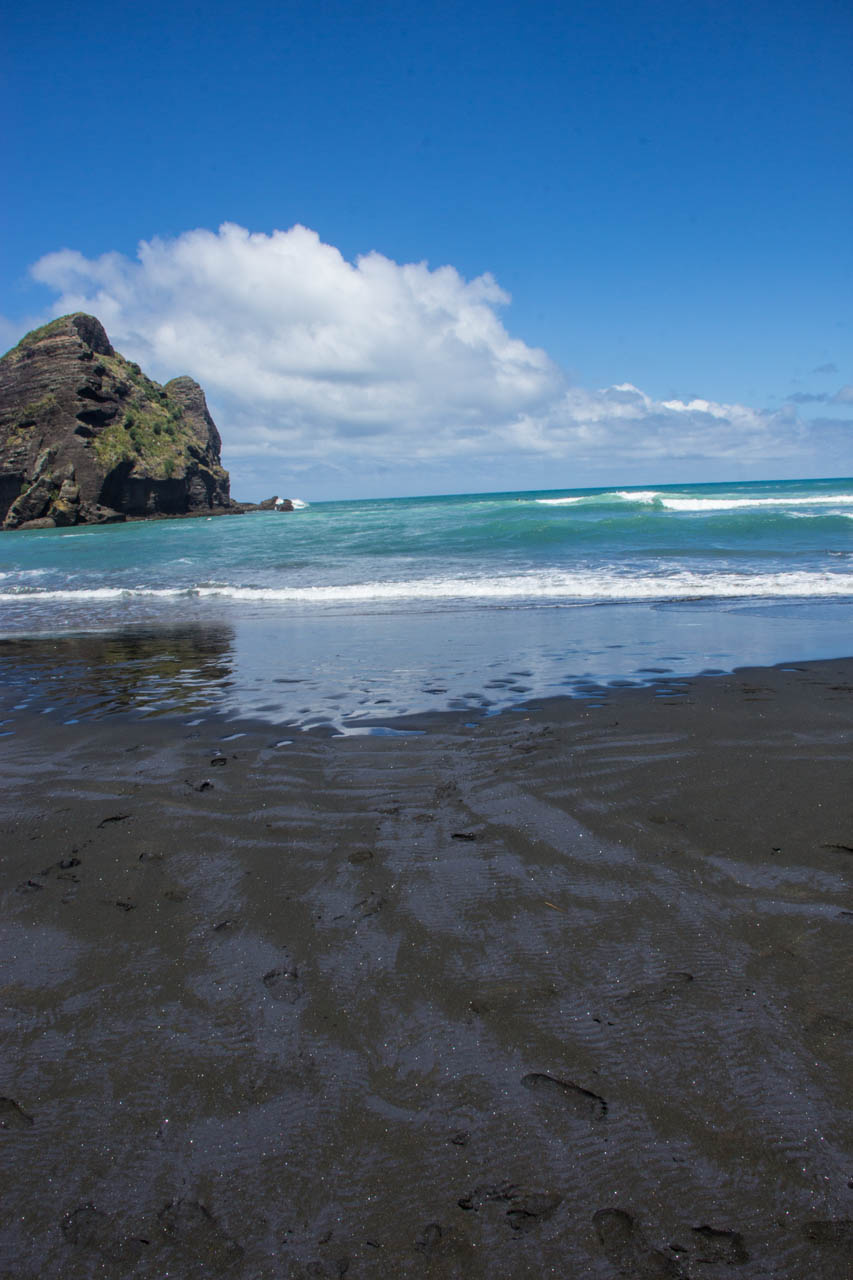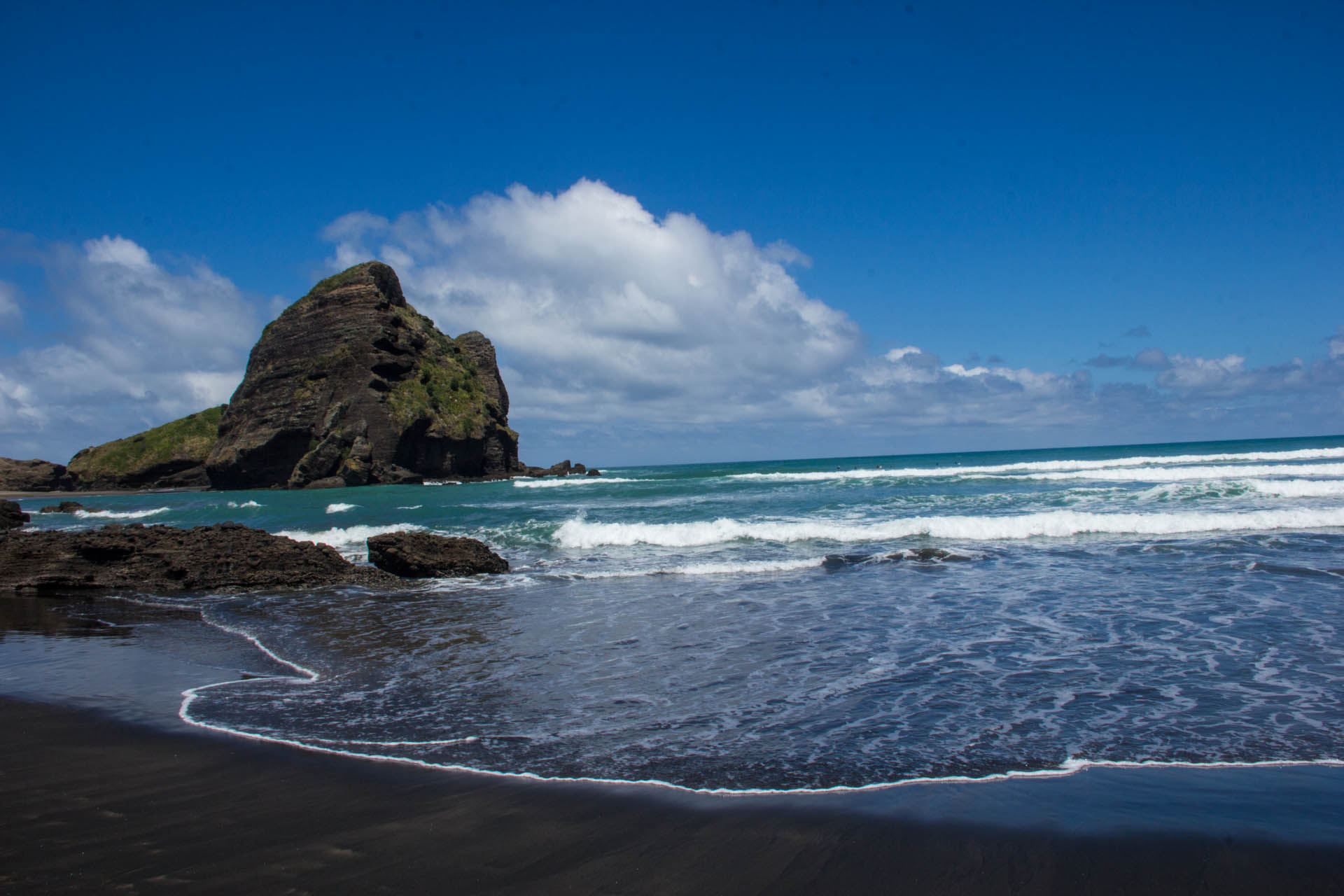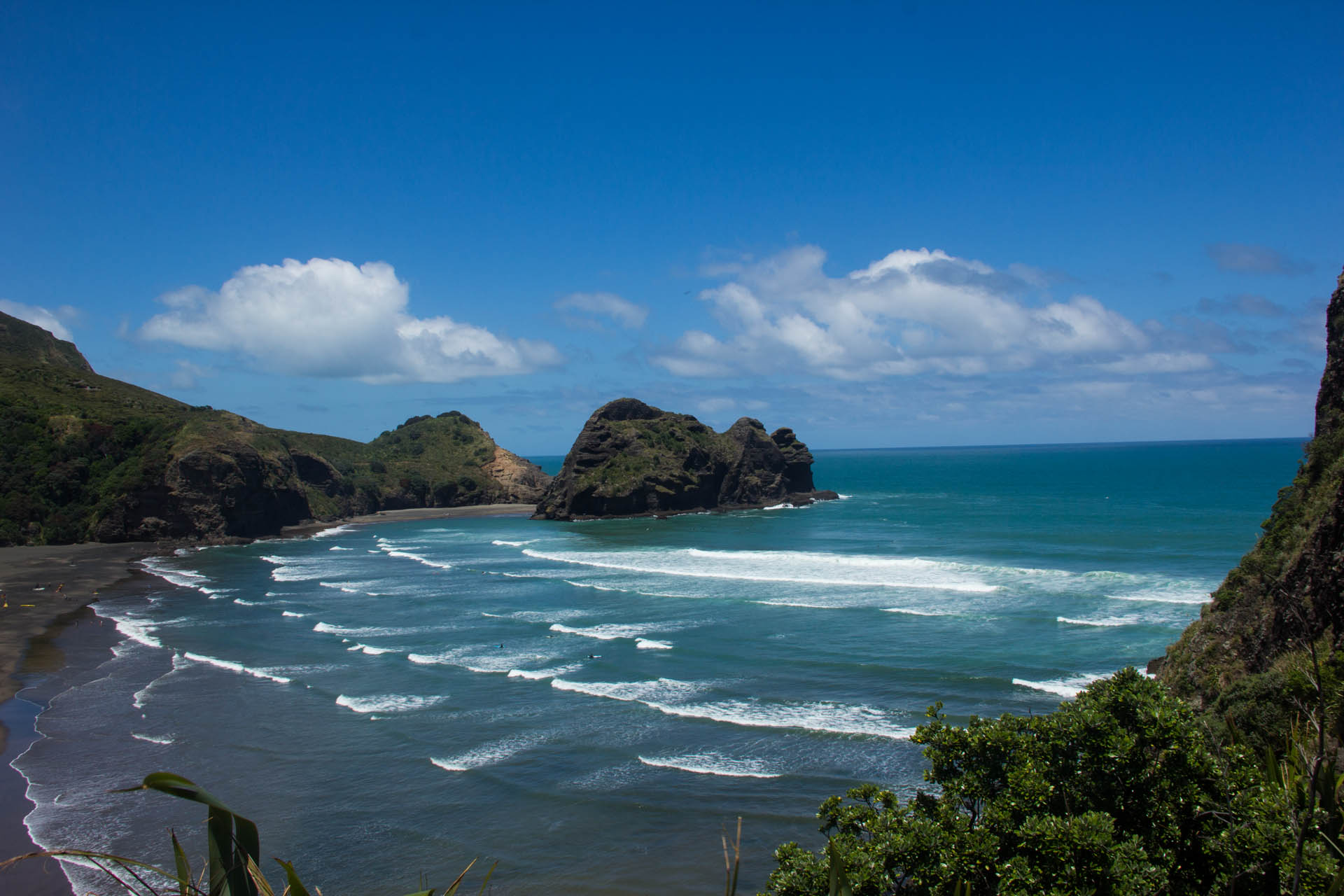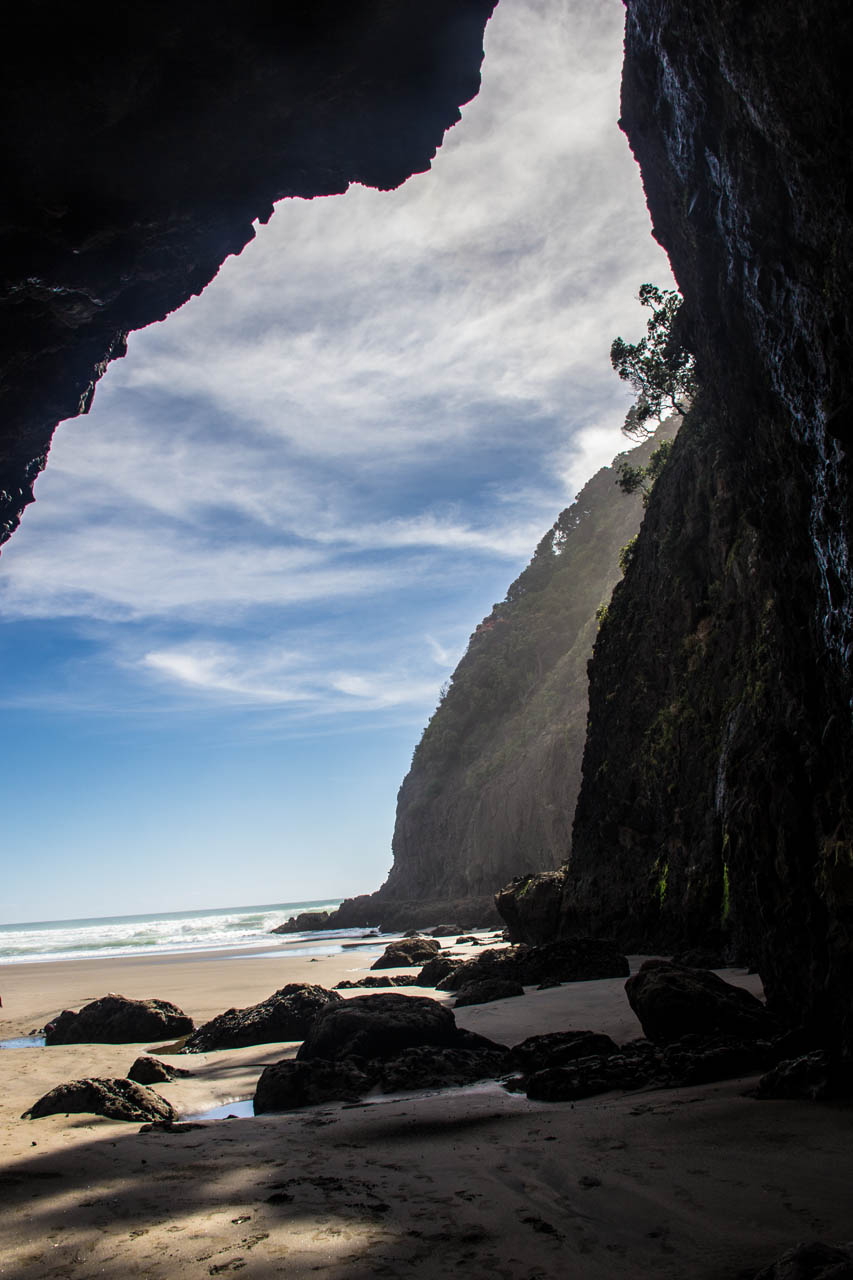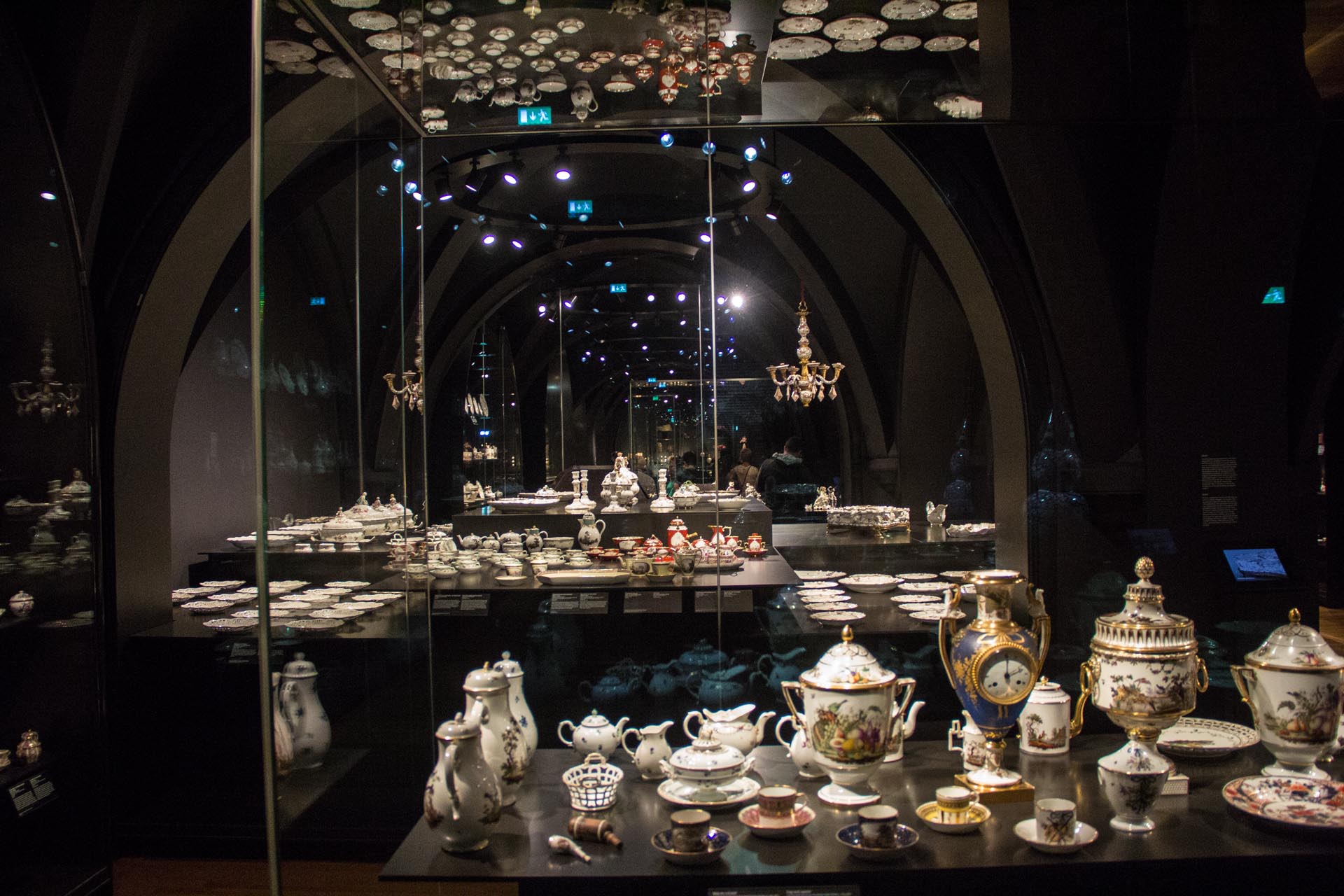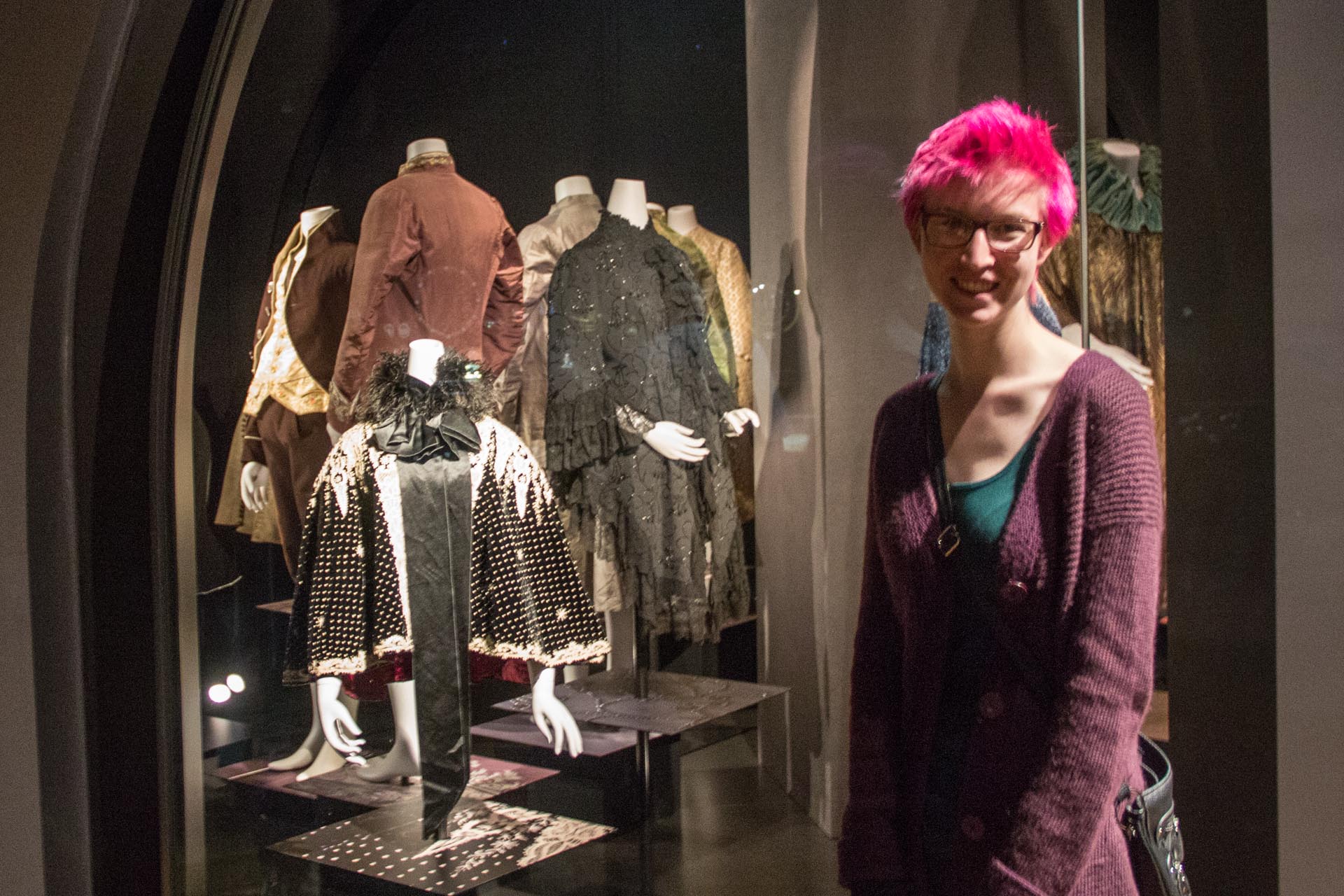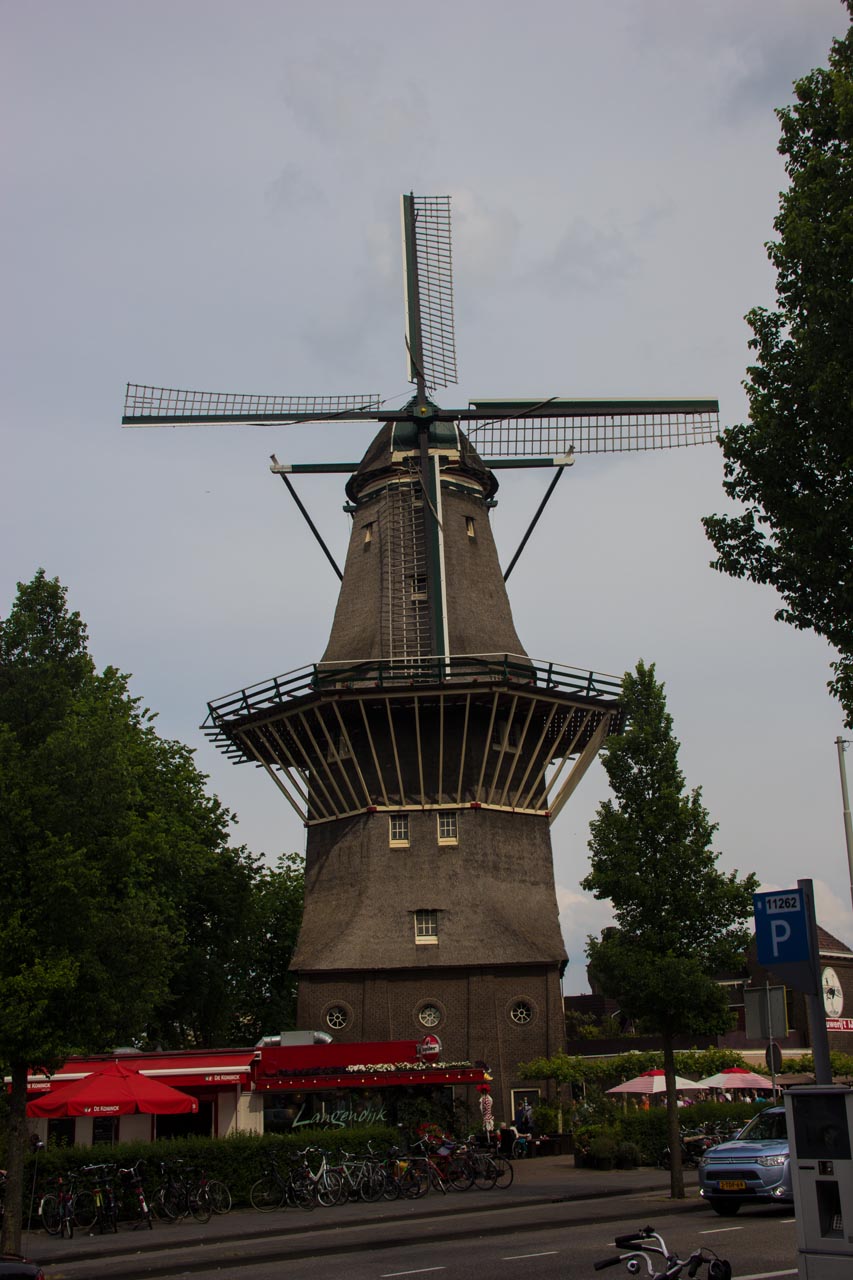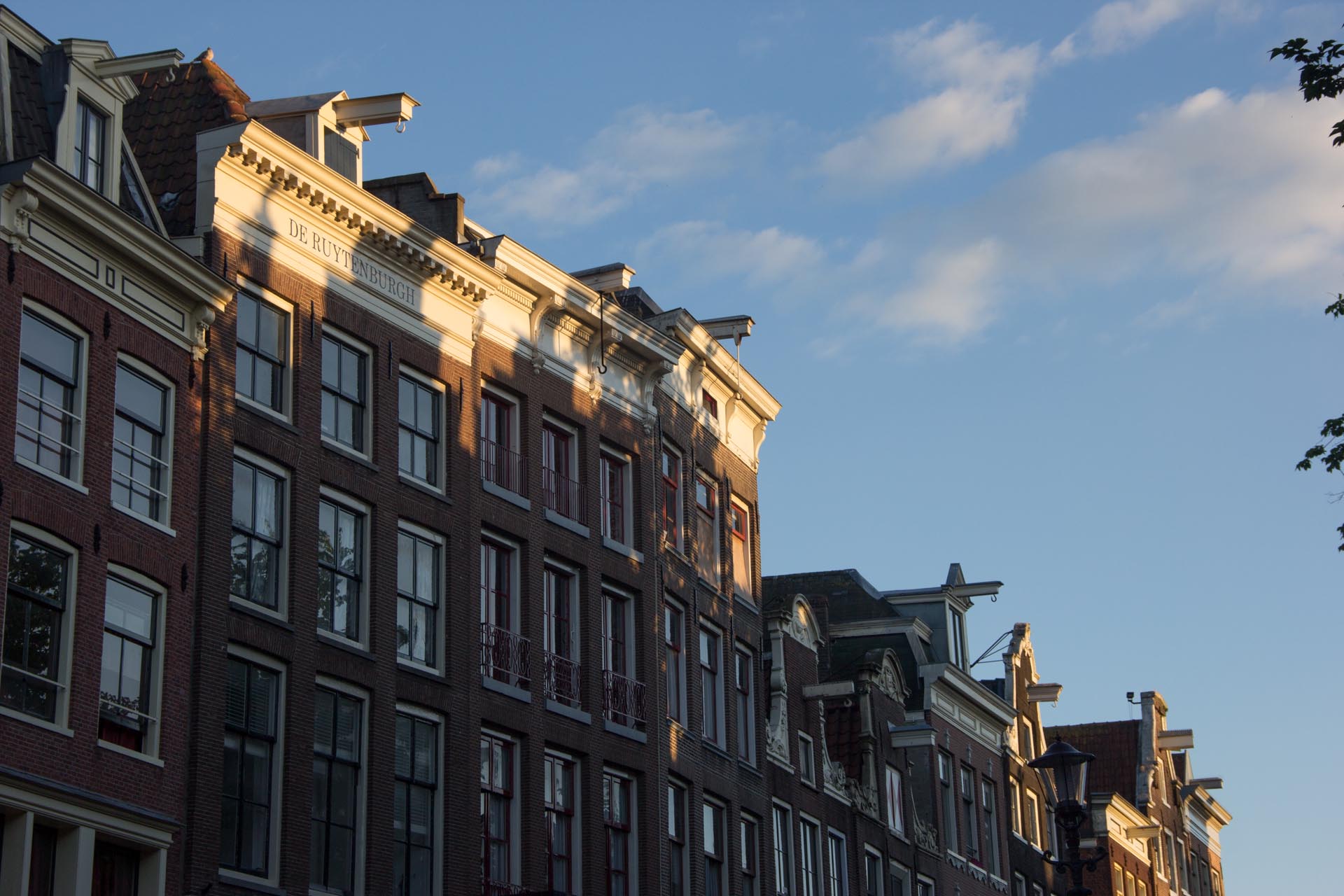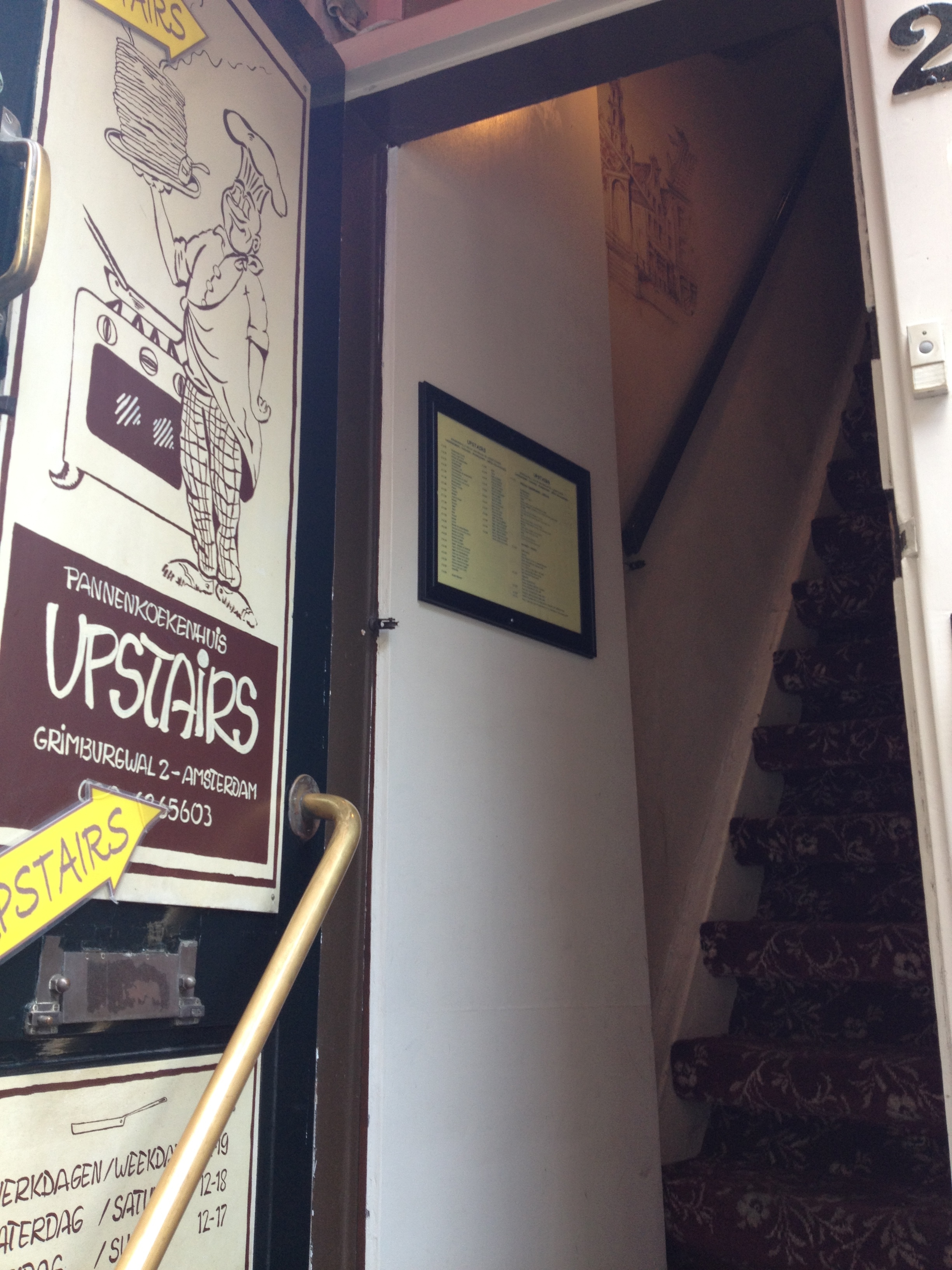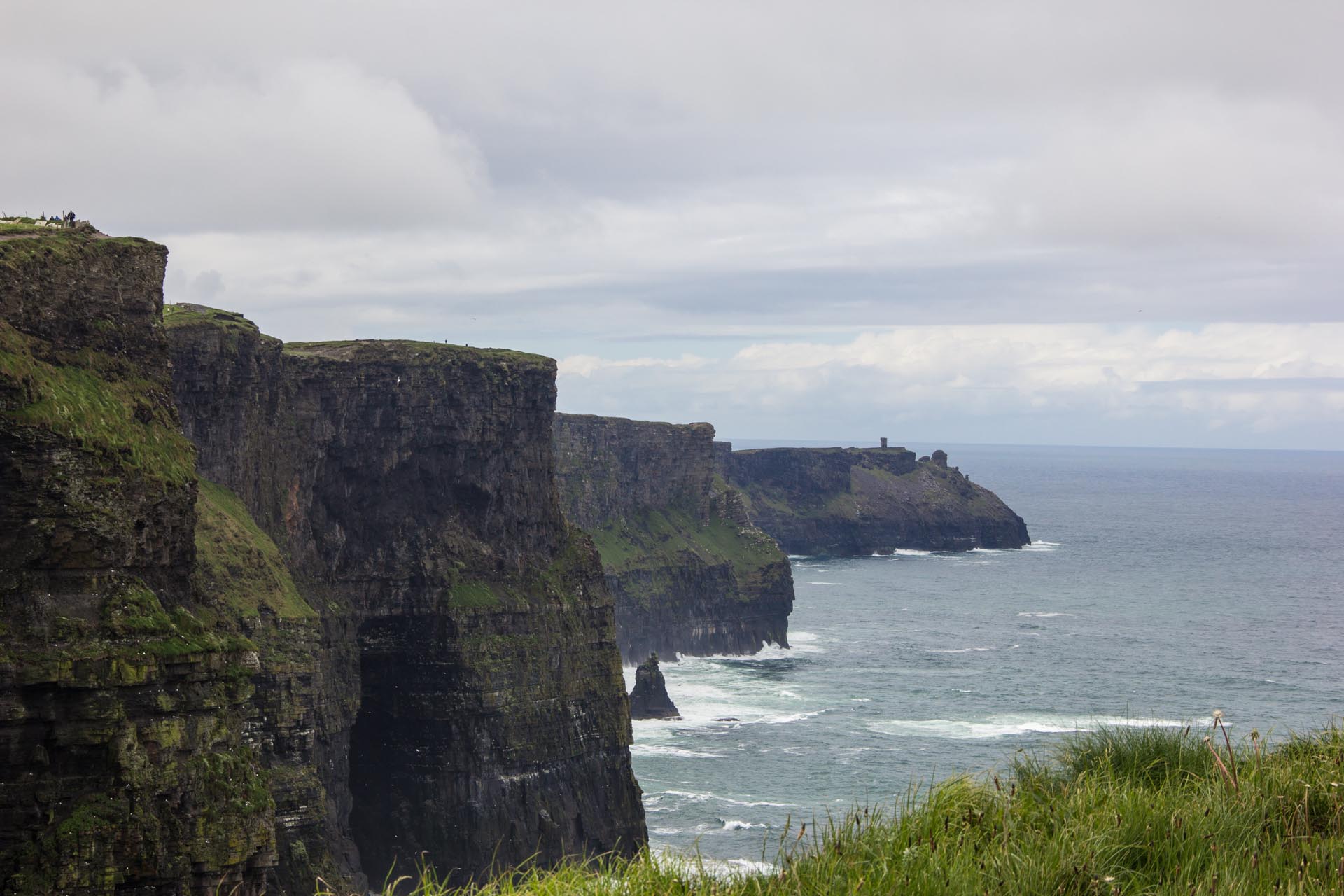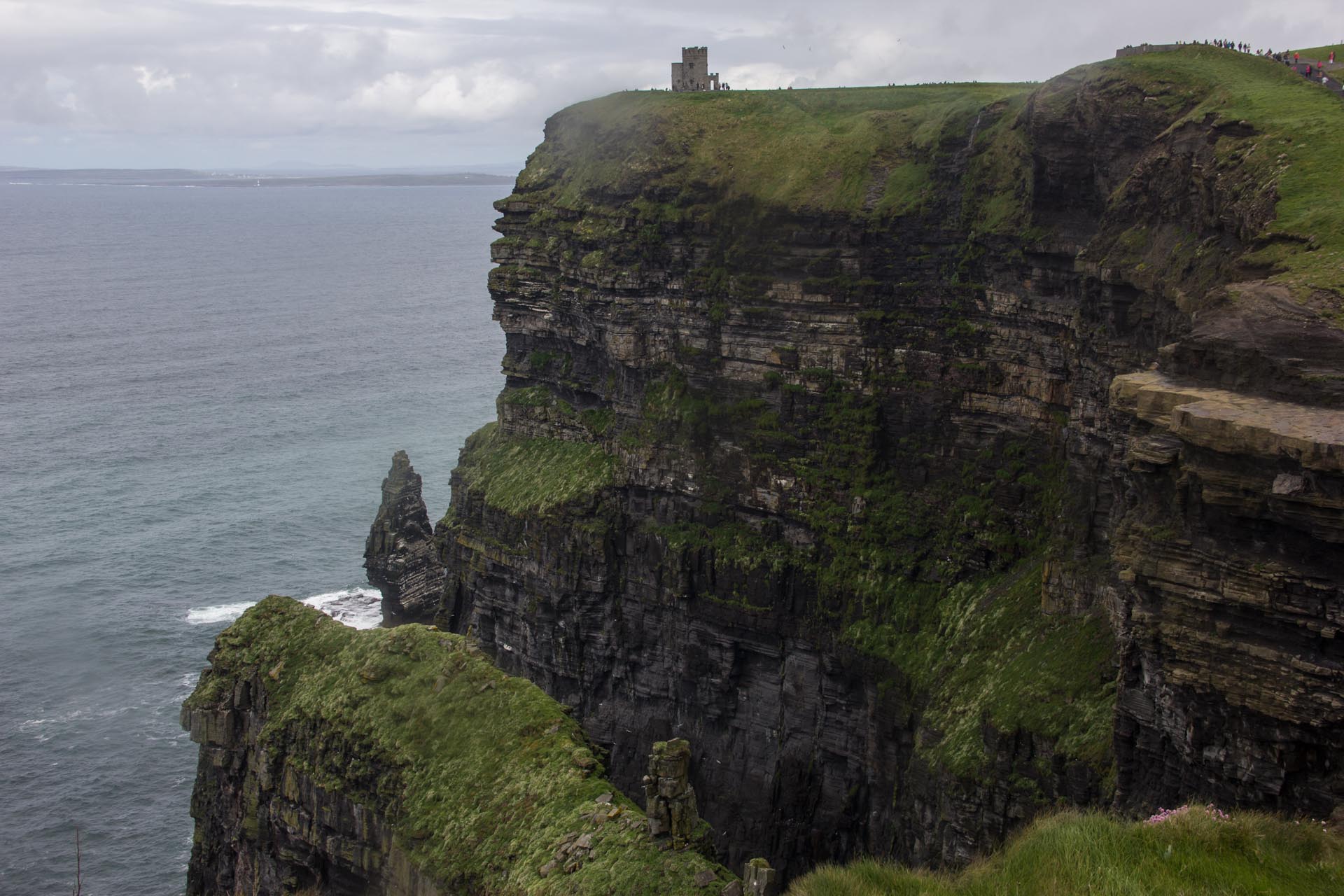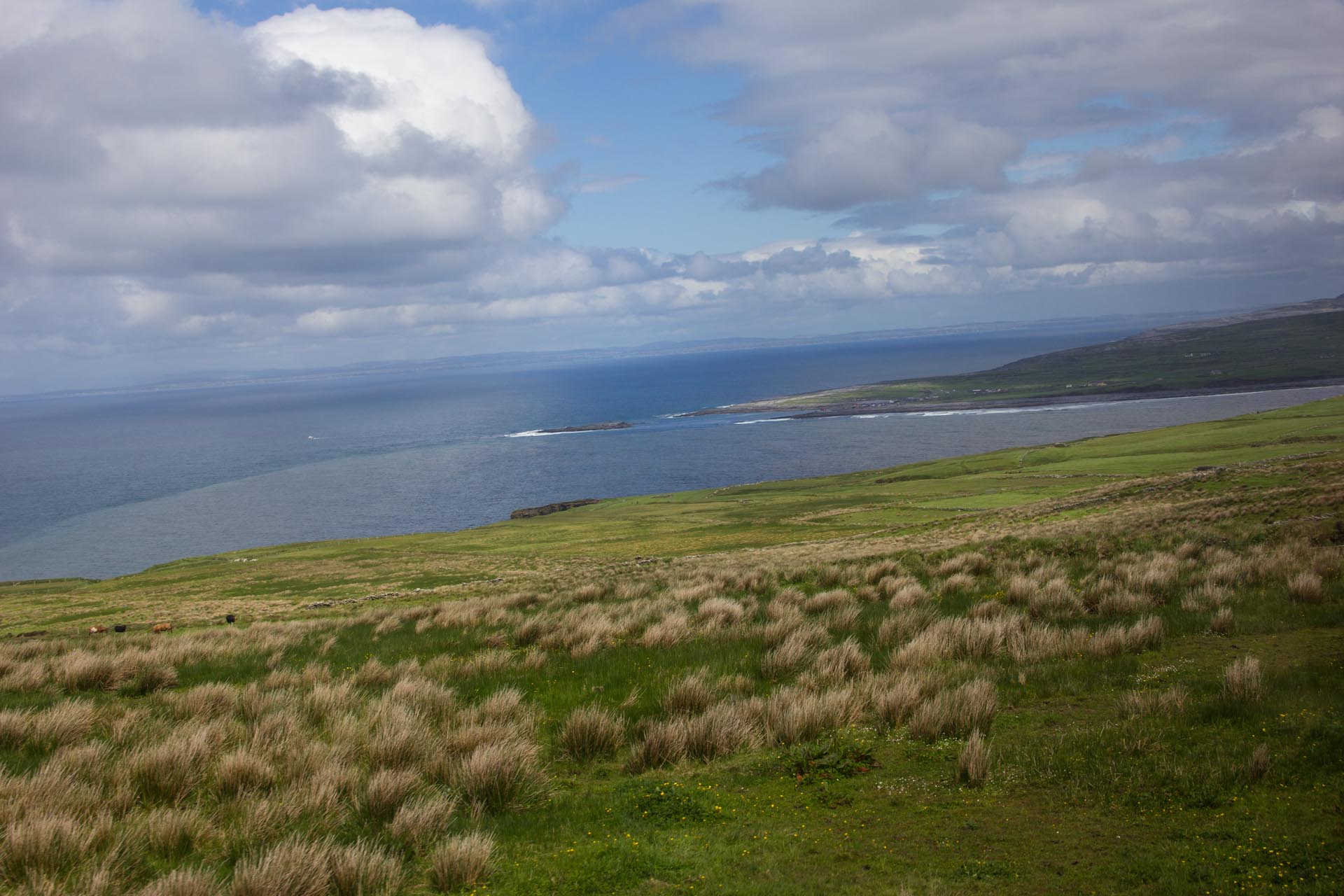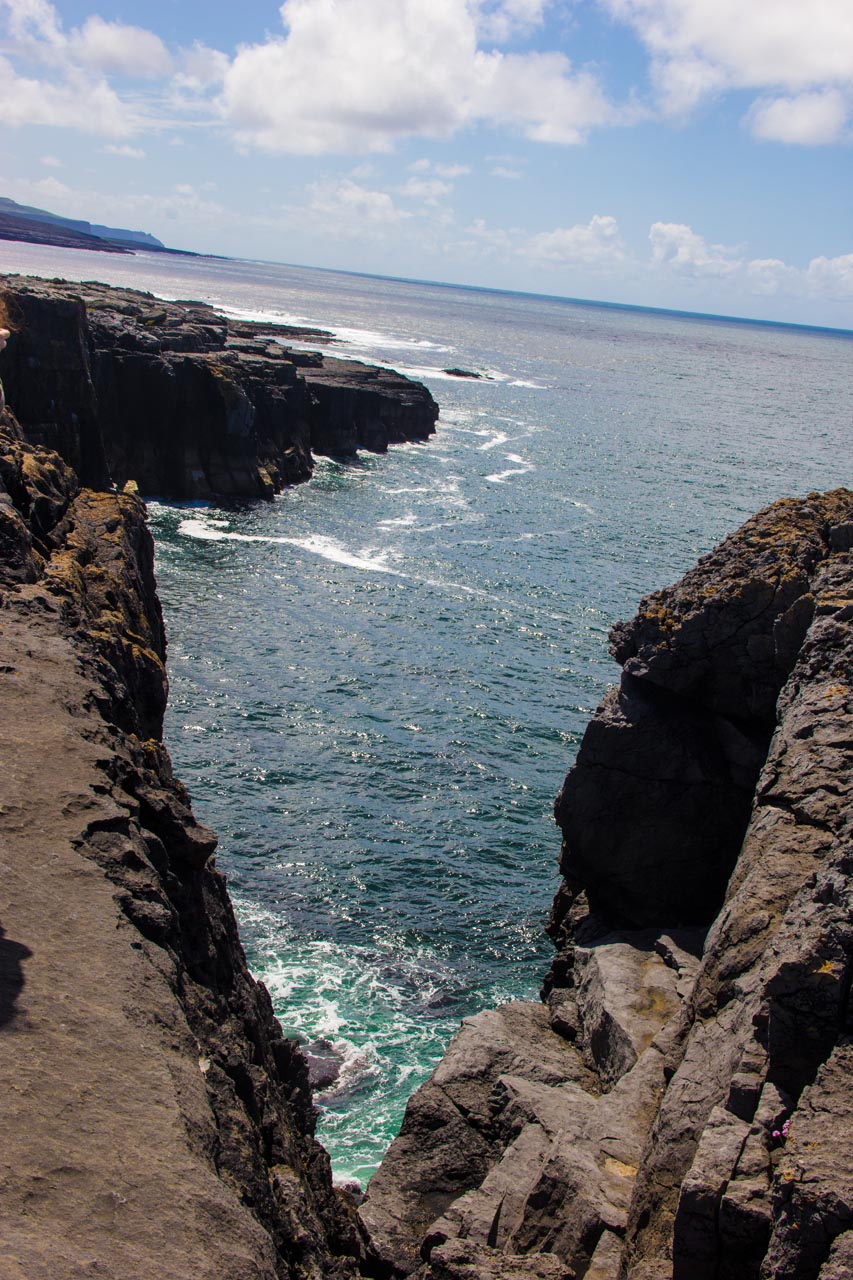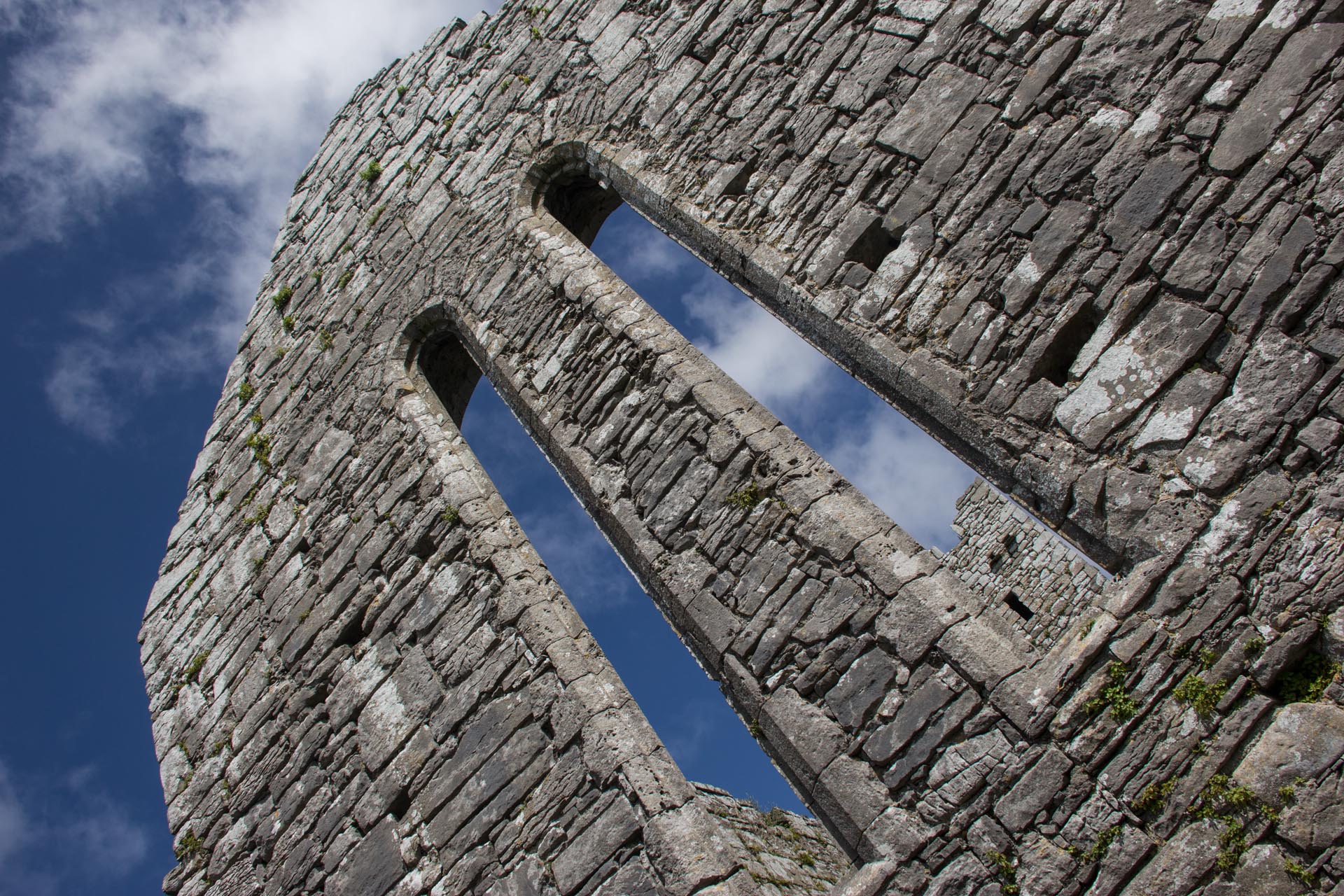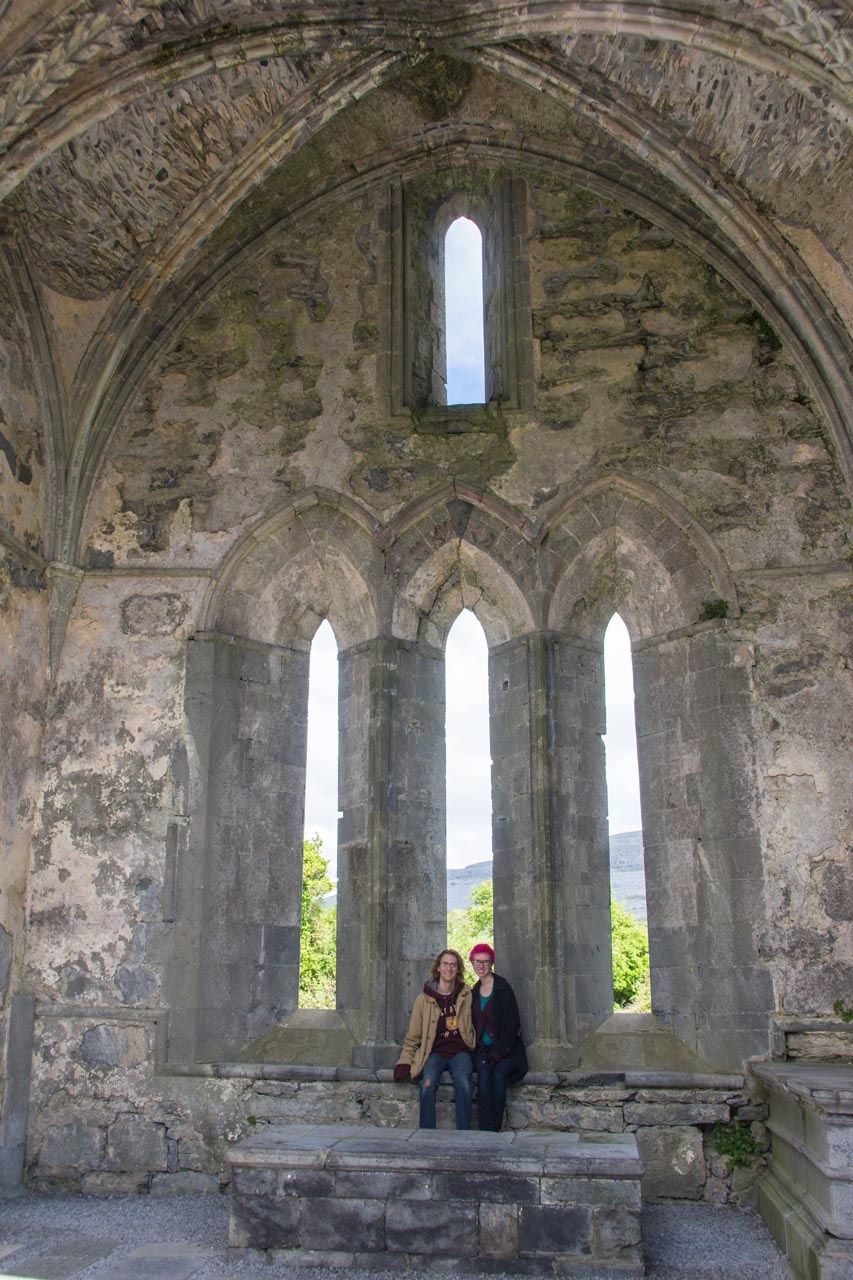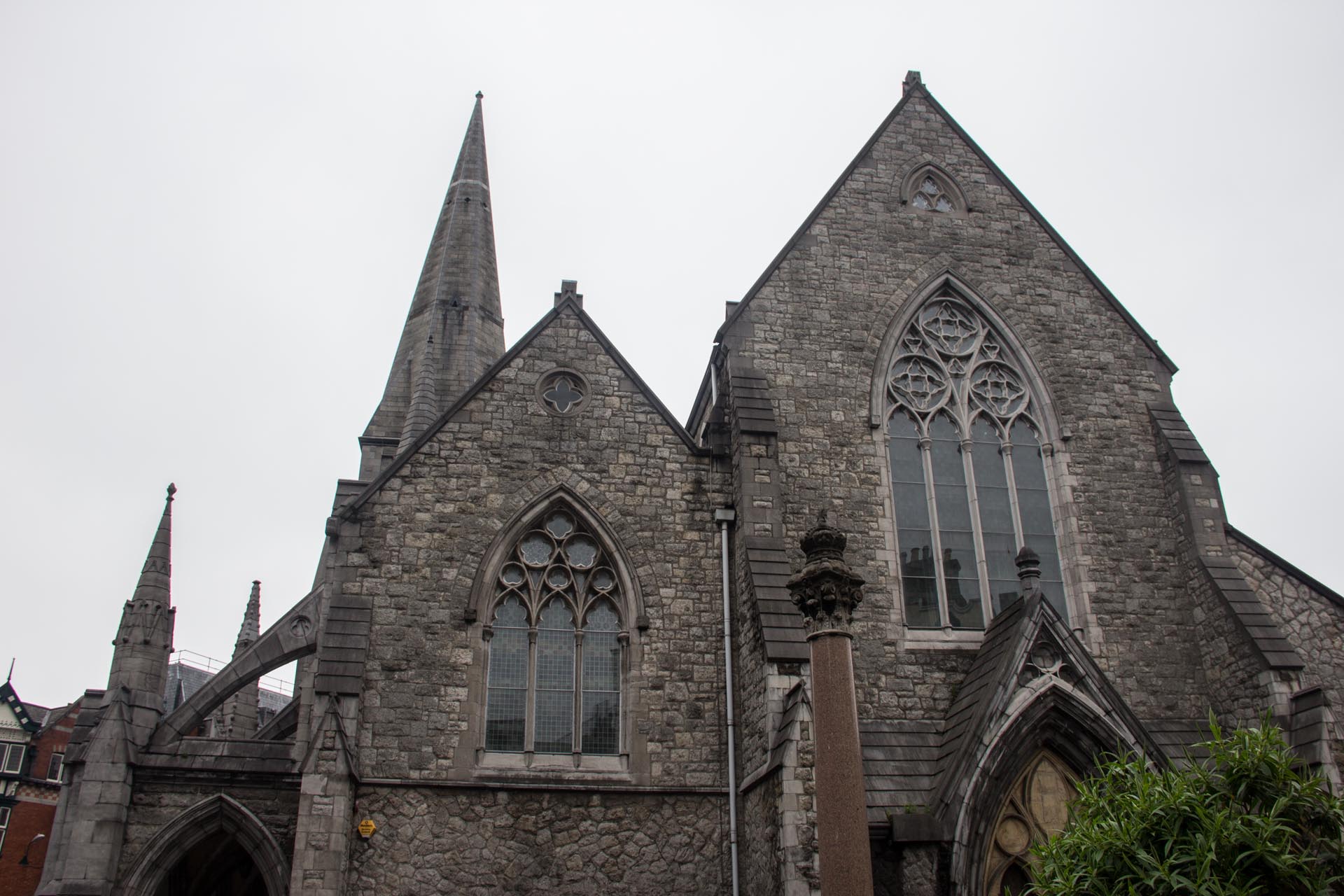In which the perfect hiking shirt is made, and an adventure is had.
Read MoreThe Traveller Dress
In which I take advantage of Kiwi resources (and sheep), make a dress, and go on an adventure.
Read MoreIn Which the History of Gold is Deceptively Rusty (but still pretty awesome)
The next New Zealand weekend adventure found us driving down winding mountain roads on a day that seemed unbearably hot in the sun, yet just the right side of chilly in the shade. It seemed the former wasn't much of an issue, because the place we were going had plenty of trees- not to mention some other pretty wonderful things:
Welcome to Karangahake Gorge! Aside from its position as a truly spectacular piece of nature, this area is filled with the rich and ongoing history of its own: Gold. I'm used to elementary school stories of men heading west to California to pan for gold in the rivers, but this venture was a little bit more subterranean. You're looking at a turn of the century gold mine, and although mining here was suspended decades ago, there is still as they say, gold in them there hills.
Karangahake Gorge is now a reserve space with some truly fabulous walking trails that I will get to in a minute, but also some pretty great informational signage about it's history. I may or may not be a huge nerd about informational signage- it's just nice to see a thing, and then learn about the significance of that thing, is all. Example: this is the view looking over the main battery. Excavated dirt (with the gold ore mixed in) was brought to this building using water from the river, where it was pulverized ("battery" like "battering ram" not the kind you stick in flashlights. This was before widespread electricity was a thing) -so the gold could be extracted. At one time, this area was responsible for more than 60% of the gold production in New Zealand.
There are a few trail options around Karangahake Gorge, but I was informed that the underground pump house and windows walk were going to be our best options. The walking path here follows what was previously train tracks: used to carry gold ore out of the mountains. It's carved into solid rock at the edge of the gorge with a very solid railing to protect curious types from the 50- to 75- foot drop into shallow, rocky water below. In some areas, the tracks have themselves experienced that fall. The twisted, mangled remains of steel and the occasional rail road tie or pipe have settled in the water below, and a new trail has been carved deeper into the gorge next to the washed out area.
Although it's a reserve, and meant for exploration- some areas of the mine are still dangerous and closed off to the public.
Gotta keep those hobbits from sneaking through the mine shafts, you know. Pesky Bagginses and their shortcuts and invisible gold rings. I wonder if there's invisible gold in these mountains!?
But what's this ahead? Could it be? My first ever real live swing bridge?!
We paused for a photo-op, of course, because- let me 'splain you a thing'-when you've spent the majority of your life (and all of your independent adventuring life) smack in the middle of the Midwestern United States- there are no swing bridges. This is because in the Midwestern United States there are no hills to connect with bridges. Everything is flat. Flat and ocean-less and full of farms with corn and cows. Swing bridges and oceans were two things I wasn't really sure I needed until I had experienced them, and let me tell you, swing bridges are pretty awesome.
Say Cheese!
The swing bridge took us up a path to a sign that said the underground pump house walk was currently closed- disappointing, because that just sounds pretty awesome. We hypothesized that there were structural issues and hoped they were temporary. Karangahake Gorge is a day-trip's drive from Auckland, and I intend to go back to see if it's open. We did, however, get to experience the famous 'Windows Walk'.
After a great many stairs (so many stairs...) we follow a dark tunnel cut into the side of the mountain. From the main tunnel, several auxiliary tunnels are carved both right- further into the mountain, and left- out to the steep cliff and overlooking the river. These left tunnels end in 'windows' which we use for light as we wander through, and which the miners used to deposit whatever they dug out of the mountain into waiting train cars below. From one of the windows, we looked down and saw the swing bridge we crossed to get to this point:
About halfway up the left side of this photo is a little dark spot- that's the entrance to the Windows Walk- at the top of the stairs. Unfortunately, this area was also plagued with some structural issues. Only half of the walk was open, after which a barricade forced us to turn around and head back. Usually, the carved tunnel goes all the way back to the beginning and deposits you in the parking lot where you started, but hey- another reason to go back, right? We took a little detour to follow that train track from before in a new direction- here you can see the old path falling away and the new path next to it.
Some of you may recall that I did a semester-long black and white film photography study on the process by which nature constantly attempts (and succeeds) to break down and take back the byproducts of human intervention. This place was ripe with exactly that- old, rusty bits of machinery abandoned by anxious entrepreneurs on to the Next Big Idea, the worn train tracks and water pipes still in place amongst new growth of trees and shrubberies. As soon as we humans turn our back on something, nature begins the slow reclamation process.
There are some opportunities to climb around on the old machinery- or if you're a huge nerd like me, to take pictures of it. It seems in every capacity like the miners rushed out as quickly as they rushed in- leaving the slowly rusting detritus of their trade wherever it happened to land.
I wonder if the miners appreciated the views they had in these mountains while they were prospecting. Probably not, deep in the belly of the mountains, but maybe when they came up for air. This place is nestled amidst mountains and is a beautiful thing all it's own. Maybe it was less so when the miners were uprooting it for minerals but nature has had the better part of a century to take it back now, and she's done an admirable job softening its hard edges.
After that healthy dose of green, and the positivity that is nature reclaiming land after the mines were abandoned- we drove a little further to an actual, real-live present day mining town with an active pit mine.
Things happen a bit differently these days, with open pit mines instead of tunnels and shafts. There is a building down there, a house-sized office of some sort- and heavy machinery for the digging of the gold, but everything is miniscule in comparison to the size of this hole in the ground. There were guards patrolling the top of the mine (five, by my count)- probably to keep hooligans and activists from causing problems. I wonder if they get that a lot. The Kaimai ranges (Where the Karangahake Gorge Mine was located) are still filled with gold, but the protected land status means it can't be mined. Currently. This area wasn't so lucky, but given enough time after it's abandoned in search of more lucrative ventures- I have confidence that nature will take back this pit and make it once again beautiful. With our back to the pit mine buzzing with activity, we were met with a very interesting site: at the end of a pair of tracks was a suspiciously old looking building with a suspiciously new looking foundation.
The Cornish Pump House was a relic of bygone days when water was used to power the mines. It fell out of use when it was replaced with electricity, but was preserved because of its historic significance. The informational signage here was a little sparse, but between that and the internet we figured out the basic story: In 2006, surveyors realized that the ground the old pump house stood on was unstable because of the mining operations right next door, and a very large effort was made to relocate it. The tracks are teflon-coated concrete pads which the pump house was slid along on for 300 meters to its new resting place as you see it today. Visitors can wander around inside and see how the operation worked (and which spots are now the best places for bird's nests as they flit about above...) and if you're a huge nerd like me, take pictures of the architecture.
It's sort of nice to see the old parts standing watch over the new things, as if to say that everything will settle back into its rightful place eventually. I love adventures like this- and it's not often you get to see the progression of history right up through present day- even if the present day part isn't exactly all warm and fuzzy. Who knows what these places will look like in a century- they've certainly changed a lot in the previous century. It might just be that I have a soft spot for historic places, and you know how exciting the Piha adventure was- how am I supposed to pick a favorite, though? Was Piha better than Karangahake Gorge? I'm refusing to answer that question. On principal.
(Retroactive) Containment Issues
Preface: I may have kinda sorta stopped blogging because I was too busy having crazy wild fun in New Zealand... I'm back in St. Louis now- so prepare yourselves for some hardcore retroactive adventure blogging! Here's the thing. I went on this adventure- and the whole thing lasted, in its entirety, for approximately 8 hours. As far as adventures go, that's just a blink of a moment in time...especially since two of the hours in question were spent driving to and from the destination. Especially since this whole 3 month New Zealand trip is an adventure. Especially since all life is an adventure.
But get this. I'm going to have to split that 8 hours up into three blog posts, because otherwise the level of grand miraculousness that occurred on this adventure will not adequately be described and that, my friends, would be a travesty.
You see, before The Void took me to New Zealand, the number of times I had personally interacted with oceans could be counted on three fingers. After just a few weeks, I'd encountered my fair share of beaches and oceans, and up until this day I felt like I had a pretty good handle on the whole situation.
But then this happened:
New Zealand separates the Pacific ocean (east) from the Tasman sea (west)- and further along west is Australia. It's not one of those "I can see Russia from my house" type scenarios though- it's a bit further away than that. Piha was my first experience with the Tasman sea, all the other beaches I'd been to so far were on the Pacific side.
Sheep insisted his picture be taken before we moved on:
As a side note, shortly after this trip Sheep created his very own Tumblr and he's pretty popular. Like, way more popular than me...
I took 491 photos of this adventure (part of the reason it's getting split up into three posts)- and you'll see why. How can you not when everything's just so pretty?
One of the first things I noticed when we got out of the car was the sand- It's called a black sand beach, but really it's a combination of normal colored sand and iron from volcanic rocks, which darkens and gives everything beautiful, shimmery effect. The beach literally sparkles, and it's fabulous.
The iron deposits are washed up by the waves, and sit on top of the sand. Next time, I'm bringing a magnet and science is going to go down.
The second thing you should probably know about Piha is that it's one of the most dangerous beaches in New Zealand. It's one of few surf beaches I've been to, and the currents here are so dangerous that it has it's own TV show: "Piha Rescue". - However, the waves are pretty excellent.
The trip was mostly exploratory, though. I still can't surf (patience, grasshopper. Next time), and the water's a bit chilly anyways- but it's gorgeous even if you choose to stick to dry ground. There are three sections of the beach, and it's safe to say that the most interesting bits are only accessible at low tide. By a very lucky coincidence, our visit was well-timed.
Not only did we get there just as the tide was going out, it went out much further than usual while we were there. According to Google and my middle school science teacher, this is called a "Spring Tide" and occurs during new and full moons. The more you know.
As we were looking around (read: as I was taking pictures of the ground...) Jon told me about a second beach that is only accessible at low tide (it's a fairly common dilemma with the beaches here), and although the tide was going out, it wasn't low enough yet. While we waited for the water level to go down, we wandered over towards another interesting landmark.
Lion Rock! it looks more or less like a lion depending on where you stand, but the general idea is there. When the Māori lived here, they used Lion Rock as a lookout and defensive position, and were quite successful at defending their land from invaders for a very long time.
It's a short, steep climb up to the lookout, and definitely worth it for the views. If you look closely, you can even see a few tiny surfers amongst the waves! Straight ahead you can see the extension of beach that I talked about earlier- we'll get to that in a minute.
There's a little grassy patch on top of the lion's head for your sunbathing pleasure, and it also happens to afford a pretty fantastic view of the beach and village below. From the top, I learned a thing or two about what, exactly, makes Piha so dangerous. There's just the boisterously breaking waves crashing up onto the beach if you look to the south, but looking over the north beach is a different story entirely. There, amongst the breakers, you can see the twisting patterns the rip tides create in the surf, and the places where the pull is so strong that it drags sand up from the ocean floor. This definitely isn't a swimming beach- and when people don't heed that warning, it makes for some very dramatic television.
For a bit of a reference, here's a view of the climb back down Lion Rock. It's a steep and well worn path, but not an issue even if you're not very sure-footed. One thing I discovered pretty quickly is that aside from my low level of general physical fitness, I specifically have a pretty awful sense of balance. Even though I felt like I was going to fall for most of the walk, I still managed to do it without so much as a skinned knee.
After climbing down from Lion Rock and a quick snack break, the tide was low enough for some secret-beach explorations. We climbed over the barnacle-encrusted rocks and stopped to investigate many a tide pool ecosystem, and I took some pictures to document my efforts at keeping my bright pink dye job from fading in the sunlight. New Zealand's UV rays are, after all, 40% more intense than the ones in the US.
After a bit of climbing, and some hilarious moments concerning my inability to balance myself upright with anything less than three points of contact -(I see you there. You think I'm kidding. I'm not.)- this is what we saw:
This whole 'Grand Adventure in Three Parts' occurred on a Monday, which is not-generally speaking- a very popular day for beachgoers, so the whole place was virtually empty. Even fewer people ventured around to this little corner, so my job as ~Official Photographic Evidence Gatherer~ was pretty easy. You'd have to actively try to take boring, ugly pictures of this place.
If you walk all the way down so far that you run out of sand, this is what you see. The beach gives way to nothingness, separated from the ocean only by a rocky outcropping against which the waves crash violently (in sets of seven, I learned). Behind this is an area where, I was informed, seals and penguins might bring their young to keep them safe while fishing. Alas, it was neither seal nor penguin season, so we didn't spot any mammals this trip (other sea life on the other hand... well, stay tuned for part 2!)
Three pictures ago, you may have noticed a rock to the right of the beach. Here's another view:
This little channel goes, obviously, all the way through the rock. Apparently people (more adventurous than myself) even swim through it! Nature is the coolest thing ever.
We decided to spend the hottest part of the day in the shade by taking a short hike up into the hills to see a waterfall; but that's part three of this little adventure. After that, and lunch under a flowering Pohutukawa tree, we tried our luck at the north end of the beach.
This end had a whole bunch of truly fabulous tide pools and sea life that we are not talking about until next week because there is too much and it is overwhelming and even as it is I may still explode...
There was also this very cool cave.
Below, we can see a very nice specimen of mermaid hair, which as we all learned in school, grows on the rocks until it is long enough that it can be harvested and worn by the mermaids.
The mermaids, because of this, have bright green hair which blends nicely with the green-blue of their oceanic habitats as well as the various jewel tones of their tails. Of course, some of the more rebellious mermaids have been known to dye their hair 'weird' colors like blonde and brunette, and some of them don't even tell their parents they're doing it first. Some people will attempt to convince you that this is not mermaid hair at all and is instead seaweed, but those people are wrong.
As the sun went down and the tide started to roll back in, (neither the first, nor the last time we almost got caught by the tide on this trip) we headed back to the car, I took pictures of the colors changing as the daylight faded, and we evaluated the condition of our sunburns and tan lines.
Did you make it? Are you with me here at the end of this post? Did you scroll through the pictures thinking to yourself: "My, they just keep going- when will it end?" - well here it is. I've made it through one third of this single-day adventure. Probably less than a third, if you consider the number of photos I have for next week's post. This is what happens when you release someone with a formal education in photography on a beach for (basically) the first time in her life and tell her to go crazy. I can, having already returned from this trip to New Zealand ('tis only the first of many!), look back on this adventure in comparison to everything else that happened and say with pretty secure certainty that it was still one of the best parts of the trip. There are so many things you don't think about when you don't experience them firsthand. Sure, you learn in elementary school that the ocean's tide goes in and out- that there are seven quintillion, five hundred quadrillion grains of sand in the world, that crashing waves carve patterns in rocks, and that a variety of sea life living in these nifty little things called 'tide pools'- but until you see it? I don't think you fully understand it until you're standing in the middle of it, and it's jumping up to nibble at your unsuspecting toes.
The Grand European adventure part 3: Amsterdam
Hi. Again. I sort of up and ran off to Maine for two months before I was done talking about Europe, and ignored the fact that I have a blog, and kind of a lot of things happened in those two months- but come with me for a ride back in time to Amsterdam, and we'll be caught up soon: I've been on a lot of planes at this point in my life, but I will never get tired of taking pictures of The View From Above. The interesting thing is, it's different in every place.
We flew in at night, and began the next day with an exploration of the Rijksmuseum- which is large, intimidating, beautiful, and awesome. So awesome, in fact, that I would very probably go back to Amsterdam just to go there again.
There is a huge room full of model ships:
There is a huge room of Porcelain:
There's even a huge room full of costumes and clothing from all over the world and all through history! There may have been note taking here...
There were a lot of people crowded up in the paintings gallery, especially since a Rembrandt was involved. Art is awesome, but when you have to fight your way through a crowd of tourists to get close enough to something to really see it, it becomes less exciting. I'm the kind of person that likes to do that sort of examination and thinking in peace, but it was pretty cool to be in the same room as some of this stuff regardless.
The Rijksmuseum also has a very old, very functioning Library of Epicness. It's the largest public art history research library in the Netherlands- and okay, it's not that big of a country, but its rich in this kind of history and I was practically drooling at all those books.
We also visited the very famous and cool Van Gogh museum, where you are very strictly not allowed to take pictures or even in any capacity look funny at any of the paintings...his Sunflowers was there, but I would really like to have seen Starry Night in person, and that one wasn't at this museum. Overall it was great to be able to see his progression as an artist and get to see in person some of the textural aspects of his later paintings that just can't be captured with a camera.
Most of our time in Amsterdam was spent wandering about the city- it's built and treated entirely different than the other places we'd been so far, and from anything I've ever seen, so I spent a lot of time being enthralled with the differences. We sat and people-watched for a while at Dam Square- a big open area in the central city that is surrounded by imposing buildings and the National Monument (WWII era).
Wandering not too far away from the astounding bustle of the central city, it's suddenly a place that manages to be quaint and homey feeling while also feeling large and intimidating.
Holland is apparently full of windmills, and you can go on a windmill bus tour, but there's really only one easily accessible one if you're not very mobile. This one is a 15 minute bus ride from the city center, and since I demanded that we see a windmill before we leave Holland, we went. Walked around it, played the selfie game, etc. They're surprisingly large up close.
There was one thing I couldn't figure out for a long time, and it's something I had noticed in a few other places during our travels- all of the buildings have these odd beams protruding from or near the roofs- some of the beams have hooks on the ends. I thought about that as we were walking around, and couldn't figure it out.
We spent a good portion of time people-watching in the red light district, which is home to a bit more than just what you'd expect. There are a lot of bars, restaurants, and shops of the sort, and I eventually witnessed something that solved the puzzle of the hooks and beams. It's a hoisting mechanism! The buildings are so small and tall, and the stairs so impossibly narrow that the only way to get something large up to your second or third floor, like say, a piano, or if you're in the Red Light District in the early evening- a full shipping pallet of Heineken- you attach a rope and a pulley to your hook, and you pull that sucker up there.
This explains that thing about how pianos used to always fall on people in the 'old days'... I wonder if anyone's had a pallet of beer fall on them...
Amsterdam's affiliations with certain pleasures in life make it an interesting place, and an interesting destination. It's wonderful to have a place that so readily displays so many Pride flags, and it's obvious that the kinds of people who aren't accepted there are the ones who have a problem with anyone else's life choices. That said, it's also a city run on tourism, and those tourists are pretty blatantly the drunken bachelor parties that have come for the sex, drugs, and booze. There are two competing factors here- one is acceptance, and one is exploitation. That's why I have such conflicting feelings about Amsterdam. I'd like to give it more of a chance- to see the rest of Holland, perhaps, and to get away from the vulgarity of the tourists and tourist-oriented gift shops.
Let's talk about Encounters with Pink Hair:
Here's a lady who wanted a photo with me- She was there for a bachelorette party, although I'm not sure if she was the bride. She seemed lovely, and we had a little conversation- but she has a plastic penis stuck in her cleavage. Take from that what you will, I suppose.
This dude, on the other hand, was the groom in a bachelor party. I saw his pink wig on their table before they saw me, but he got incredibly excited and put it on again when his friend pointed me out.
We took pictures while his friends snickered, and one of his cohorts took a selfie on my phone between photos of us:
 These guys were profoundly Scottish, which I appreciated. The pink-haired fellow is wearing a nightgown and water wings- in case he drunkenly falls in to the canal. We watched a lot of inebriated gentlemen walk by wearing ladies' dresses and inflatables.
These guys were profoundly Scottish, which I appreciated. The pink-haired fellow is wearing a nightgown and water wings- in case he drunkenly falls in to the canal. We watched a lot of inebriated gentlemen walk by wearing ladies' dresses and inflatables.
Let's talk about the other side of things for a moment:
The first thing you need to know is that apparently, whoever built Amsterdam wasn't thinking about stairs until the very last possible second.
We visited and breakfasted in a lovely little restaurant- the English translation of Pannenkoekenhau's is 'Pancake House'- and that's exactly what it is. The second story of this tiny building is a tiny restaurant, with three tables and a kitchen that was definitely smaller than the entire area of a Queen sized bed.
The place was beautiful, glorious, and perfect. The food was great, and the environment was better. There was a Pride flag flying outside the window (also window boxes! With flowers!)- and the place was run by a wonderful gay couple. One of them took orders and brought the food out, and the other was the Chef Of Amazing Netherlands Style Pancakes (somewhere between the thickness of a crepe and an American pancake. Similar to Swedish pancakes but bigger and sweeter). This is what I wanted- not drunken bachelor parties running around degrading freedom of sexuality- I wanted a gay couple working and enjoying the life they had made for themselves, and having the freedom to do that without harassment or fear. Amsterdam has the capacity to give that to people, and I wanted to see more of it.
So this is what I'm trying to say. Duality makes things interesting, and dissonance when played correctly makes you think about important issues in life, like gender and sexuality and whether or not we as a society should have a problem with boys wearing in dresses and people of any gender selling sex. Amsterdam has created for itself a place where those issues can be addressed, and it does it without putting too much strain on anyone- but there's a right way and a wrong way to wear a dress, I suppose. Are you doing it because you have made the personal choice to do a thing that makes you happy, or are you making fun of people for being different?
I want to go back. I want to go back and stay longer and in a different area where I can choose to continue people-watching in the Red Light District and try to understand what the tourists think is going to happen to them when they go there, but I also want to see more of the safe, accepting environment that the rest of the place seems to be.
The Grand European Adventure: London Calling
Our adventure began and ended in London- but before I begin the epic that is England, let me give you an idea about my feelings for London: I have, as souvenirs, obtained a London Underground mouse pad, coffee mug, and poster, a union jack scarf, English yarn from English sheep, English candy, and Many Many Pictures Of Everything.
So, you can imagine my excitement when London finally happened.
London was an adventure in three parts: the first section, the day we flew in, was that my sister Lillian and her friend Billy the British Paratrooper were going to pick us up from the airport. Heathrow has this big Arrivals hall where everyone comes out after passing through customs, and someone famous must have been flying in because there were all these teenage girls everywhere- a bunch of them yelled that they like my hair, which was pretty funny. We met up with Lill and Billy the British Paratrooper, and took off for the University of East Anglia, where they are studying. We never made it to school because there was an accident on the M11 involving a lorry, three cars, and a 'horse box' - and after being stuck in traffic for 3 hours the police told us to turn around on the highway and drive [on the American side of the road!!!] back the way we came. All the other ways to get back were blocked as well, so we gave up, exhausted and hungry but having had a good lesson on the colloquial differences between American English and British English- and also on the Cockney accent- and Billy the British Paratrooper was kind enough to show us around Essex, (a traditional carvery dinner, a pub, and some sheep painted on the ceiling of an underpass!!) and then let us crash in his house- but not before making us tea the authentic British way!
[embed]http://instagram.com/p/oCOHrTA6MX/[/embed]
(Sorry that's the grainiest photo known to man... selfies in the dark tend not to end well, but SHEEP.)
Not only was Billy kind enough to let us stay in his house and eat his breakfast, he also drove us back to the airport the next morning at 4am to catch our flight to Ireland. Because Billy is the best.
After Ireland, which I told you about in the previous post (If you haven't read it, at least go back and look at the pictures, because Ireland is so beautiful and so green!), we flew back to London to continue our adventure there.
We took the tube from the airport to our hostel, which was about two blocks from King's Cross station. The automated voice said 'mind the gap', and I had a Huge Nerd Moment about that- you can ask Aric, I was probably embarrassing. That is why I was giggling like a mad woman every time the doors opened and closed...
The first full day was another bus trip- this time to see Stonehenge and Bath:
Stonehenge is technically an archaeological site- so we couldn't go all the way up to it- can't disturb the fragile earth. Also I guess they've had problems with graffiti in the past. It is, however, kind of located on a hill, so it was easy to take pictures of just the stones and crop out most of the tourists surrounding them.
It was surrounded by pastures full of sheep, and I consider it one of the greatest disappointments of my career as a photographer that I was not able to get both the sheep and Stonehenge in the same picture. I tried, though. Oh, how I tried. Also, my souvenir from Stonehenge is an eraser that just has the word 'ROCKS' on it in a huge point size- which I feel is an accurate description of what we saw there.
After not-an-actual-henge (actual henges have some kind of ditch dug around them that this one doesn't have...I think), we continued on to Bath, where there is a cathedral that is built tall because the angels needed to climb down the ladders from heaven.
D'you see the ladders? With the little stone angels climbing down? Also, check out those flying buttresses! The building there on the right is the entrance to the Roman Baths, which I'm getting to, I promise.
After exploring the city a bit, and having lunch at a place that boasted the city's best baguettes, (they were really good... also we met a gentleman who wrote for the New York Times there, and he and his wife were hilarious) we took a tour of the Roman Baths.
The neat thing about the Baths, is that the museum lets you explore what's left of the original Roman architecture, and gives you a pretty good idea of what it would have looked like back in the day. Check out this still-functioning drain, for example:
It still carries the leftover water from where it overflows from the baths into a very complex drainage system. How cool is that!
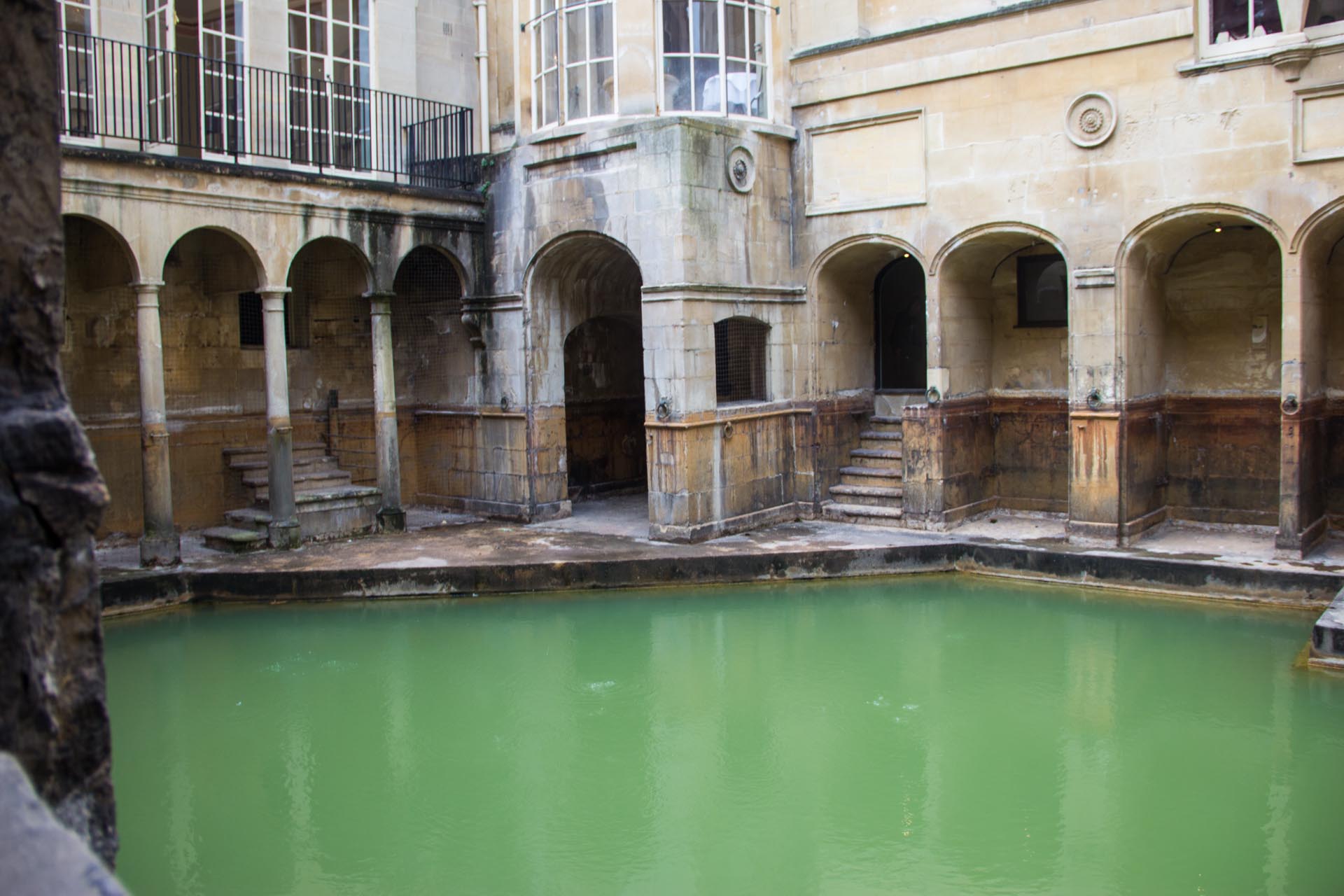 The main area had a lot of tourists crawling all over it, but this secondary area was empty. The baths aren't in use anymore, but there is a spa nearby that still uses the spring water for treatments. At the end of the museum, there's a fountain where you can try the water fresh from the spring. They really played up how it didn't taste like normal water, and it was gross and all that- but I tried it and it wasn't actually that bad. Just a very slight aftertaste, but nothing anyone shouldn't be able to handle. Since the Romans thought it had magical healing properties (and maybe it does- it has a lot of very good for you minerals in it), I also tried washing my hands in it. There were no immediate changes, but apparently it takes a few days to take effect.. plus, I didn't sacrifice anything to the Gods. It has, however, been two and a half weeks and my hands are behaving normally- so maybe there's something to it after all.
The main area had a lot of tourists crawling all over it, but this secondary area was empty. The baths aren't in use anymore, but there is a spa nearby that still uses the spring water for treatments. At the end of the museum, there's a fountain where you can try the water fresh from the spring. They really played up how it didn't taste like normal water, and it was gross and all that- but I tried it and it wasn't actually that bad. Just a very slight aftertaste, but nothing anyone shouldn't be able to handle. Since the Romans thought it had magical healing properties (and maybe it does- it has a lot of very good for you minerals in it), I also tried washing my hands in it. There were no immediate changes, but apparently it takes a few days to take effect.. plus, I didn't sacrifice anything to the Gods. It has, however, been two and a half weeks and my hands are behaving normally- so maybe there's something to it after all.
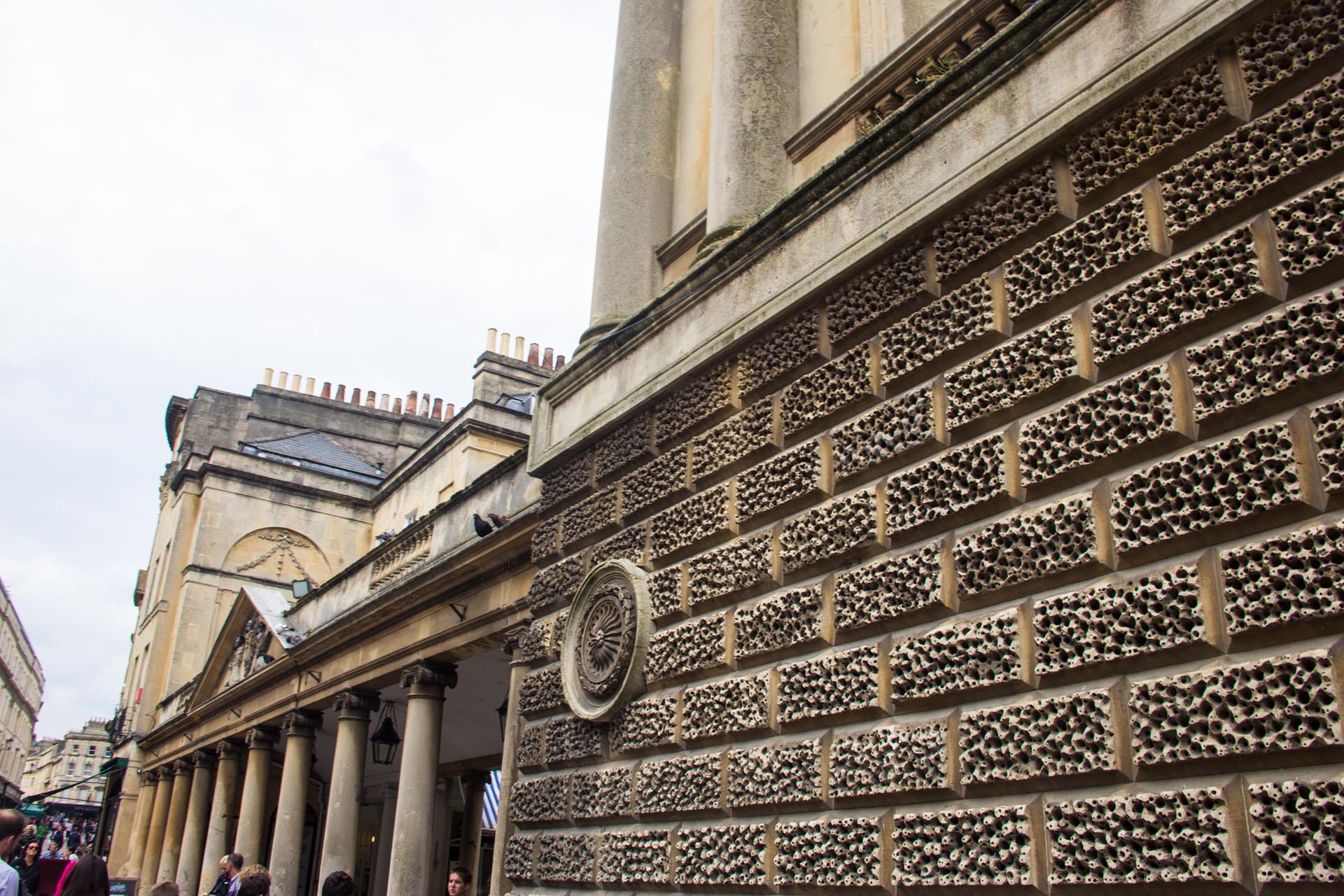 Almost all of the buildings in Bath are built from this same kind of stone, but this was the only one we saw with a porous version of it- part of the process that the water goes through before it emerges from the hot spring, is that it is filtered through porous rock like this deep in the ground. It was really cool to see it used in the buildings as well, since it is so integral to the city.
Almost all of the buildings in Bath are built from this same kind of stone, but this was the only one we saw with a porous version of it- part of the process that the water goes through before it emerges from the hot spring, is that it is filtered through porous rock like this deep in the ground. It was really cool to see it used in the buildings as well, since it is so integral to the city.
After not enough time at all, we were on the bus headed back to London. It was a beautiful day, and we both agreed that five hours was not enough time for Bath. We would like to go back and spend a week or so there- it's very laid back, and every inch is beautiful.
We got back into London around 7 that evening, explored the portion of the Thames along which lies the London Eye, Big Ben, and Parliament.
Going up in the Eye is expensive, but I think it's just as pretty from the ground anyways.
We decided to stick around and watch the sun set over Big Ben and Parliament, because I knew that Big Ben would be lit at night, and I sort of assumed that Parliament would be too.
It's a lot darker than I expected. Maybe because we light the White House so intensely here, I was expecting the same of such an important British building. We didn't get a chance to go see Buckingham Palace, so I don't know how that is lit at night. Big Ben was beautiful anyways, though.
The next day, we headed off to see the Tower of London- which is perhaps the biggest misnomer in British History. The Tower of London is a castle. Inside some walls, surrounded by a dry moat. I mean, don't get me wrong, it is very cool, and an excellent museum with lots of cool stuff- but a tower? A tower, it is not.
There are soldiers stationed at the Tower still, but it has mostly been converted into a museum.
Rather than one big tour, it is separated up into multiple sections, where you can learn about such things as the Kings that lived and ruled there, the history of English currency, conquests, armor and weapons- and, of course, the crown jewels. The benefit of this is that you can pick and choose what you see- the problem is that you have to try really hard to make sure you don't miss anything. We spent almost an entire day there. The crown jewels were awesome- even if they do put you on a people-conveyor so that you can't stand around them...and even if they don't let you take photos.
Tower Bridge (which is London Bridge if you're actually from London) was right outside the Tower walls
There was a little exhibit up inside there, but we heard it wasn't all that great, so we just took pictures instead. Many pictures.
That day was also an interesting day for pink hair and fashion sense: I actually don't know if it was the hair or the thigh-high argyle socks I was wearing, but I was glad I felt pretty okay with how I looked because people were staring. A lot. More than usual. Maybe it's because that area is really touristy, but whatever it was, it was weird. I did observe a distinct lack of tall socks in England, though, and that's not something I'm willing to give up. People are just going to have to stare, I guess.
If you're ever in London, I highly suggest you spend a day at the British Museum: entrance is free, and it has the biggest collection of ...stuff... that I have ever seen in one place. They have the Rosetta stone, rooms and rooms on ancient Egypt, Mesopotamia, and the Americas. As Billy puts it, "It's a bunch of stuff that we stole!"- and that's accurate. We stayed until close the first day, and then went back the day after.
Here's my story about the British Museum, though- I was wandering around one of the Egypt rooms- looking at this really cool beaded burial shroud that included a description of the restoration process that it went through before it was displayed because that's just the kind of nerd I am.... and this 12 or so year old kid walks up to me (right up to me. 3 feet away or so)- and he holds up his phone, and takes a picture of me! Flash and everything, it was completely the opposite of subtle. So I was just standing there, with my 'this is really interesting museum face' on, (my mouth was probably a little open, and there was probably a bit of Resting Bitch Face involved, because that is a thing that I do)- and the kid runs back to his group of perhaps 10 or 11 friends, and he holds up his phone and points at me! So of course, all his friends hold up their phones and start taking photos of me too! Flashes and everything. I wasn't aware that my pink hair was going to make me part of the Egypt exhibit, but there are now a dozen British schoolchildren with most likely terrible photos of me on their phones, and they're probably also on Facebook. It's like being famous, but with none of the perks.
Anyways, pink hair adventures aside, the next stop was Abbey Road, so we could do The Walk...
This turned out to be a hilarious train wreck, because there were a bunch of other people there, and at zebra crossings it's illegal to drive through if you even so much as see someone who might want to cross the road. So basically, all these people are standing with their toes in the crosswalk waiting for the cars to go by so they could do their walks, and all the cars are stopped, waiting for people to walk. It was a mess, but we timed our walks with lulls in the traffic, so there weren't too many cars. In order for the photo to be from the right angle though, the photographer has to be out in the road as well- so although we did the walk, the photos aren't quite right.
We also went and found both 221B Baker Streets- first the one on Baker Street, home of Sherlock Holmes, and now the Sherlock Holmes Museum,- and second, the one that is the filming location of BBC Sherlock- which is not on Baker Street at all. It is, however, really and actually the home of Speedy's restaurant and cafe, where we had breakfast!
We didn't actually go into the Holmes museum, because it was expensive and I heard that it wasn't all that great. It's a huge admission of my nerd-dom that I can say with fair certainty that I probably already know everything that the Holmes museum had to tell anyways. Fact of the day: 221B Baker Street didn't actually exist when Arthur Conan Doyle wrote his stories- the street didn't yet go down that far, so it was a made up address. Kind of like using 555- numbers in TV shows, I guess.
Also, here is a Very Important Picture of me knitting a recreation of Granny's baby blanket on the London Underground at the Baker Street station:
And some Sherlocks:
[embed]http://instagram.com/p/oVRWWLg6B5/[/embed]
The Baker Street tube station is covered in tiny Sherlock Holmeses. Some of them even make up bigger Sherlock Holmeses!
[embed]http://instagram.com/p/oUI8AHA6Ii/[/embed]
These grainy photos do not even begin to establish how excited I was about Baker Street- I don't believe the words actually exist.
We found these phone booths on the way to the Transport Museum, which was awesome, especially since the history of London Transport is so interesting. Happy 151sth anniversary to the London Underground, wheee! I'm especially happy about the Underground sign in the background. The Transport Museum's gift shop is where I got the aforementioned mousepad, mug, and poster. They also sold things made from the fabric that the seats on the tube trains are upholstered with- it's called Moquette. Each line has its own unique pattern- my favorite was the Bakerloo line, which is kind of geometric honeycomb-esque. Aric said he's more of a Central Line man, although it is distinctly possible that he was being facetious. Here's a link if you want to check out the fabrics.
So that was London. After four short days there, we were on our way to Amsterdam. I wasn't happy to leave, but I definitely plan to go back. There is one part left to the London Adventure that I'm going to include with Berlin, because it didn't happen until the end of our trip. There have been negative opinions about the weather there, but it seems to me like the weather is specifically designed for fair skinned, easily-burnt people such as myself- plus it's cool, and distinctly lacking in humidity. The accents are wonderful, the people are great. People-watching on the tube is second to none. Plus, they have great television. The tea is excellent, and scones there are much better than the scones anywhere else. Basically, London is the best, and I want to go back.
Watch this space for the Adventures in Amsterdam with Pink Hair.
The Grand European Adventure: Ireland
Hey... So, since we've talked last, a lot of things have happened: My computer crashed (twice), I got a new computer, I graduated, sold a bunch more bags on Etsy including one custom-dyed one (first time for that!), got involved in some T-shirt printing projects, and a bunch of other stuff, but we'll talk about that later, because the Very Important Thing that most recently happened is that I went on a Grand Adventure!
We visited Ireland, England, Amsterdam, and Berlin- but since telling you about the whole entire trip would end up being a terrifyingly long blog post full of a terrifyingly large number of pictures, I'm breaking it up into four bits. If, for some inconceivable reason, you just really hate Ireland and can't stand the thought of reading about our experiences there- feel free to skip this one and wait for England, which will be up in a few days.
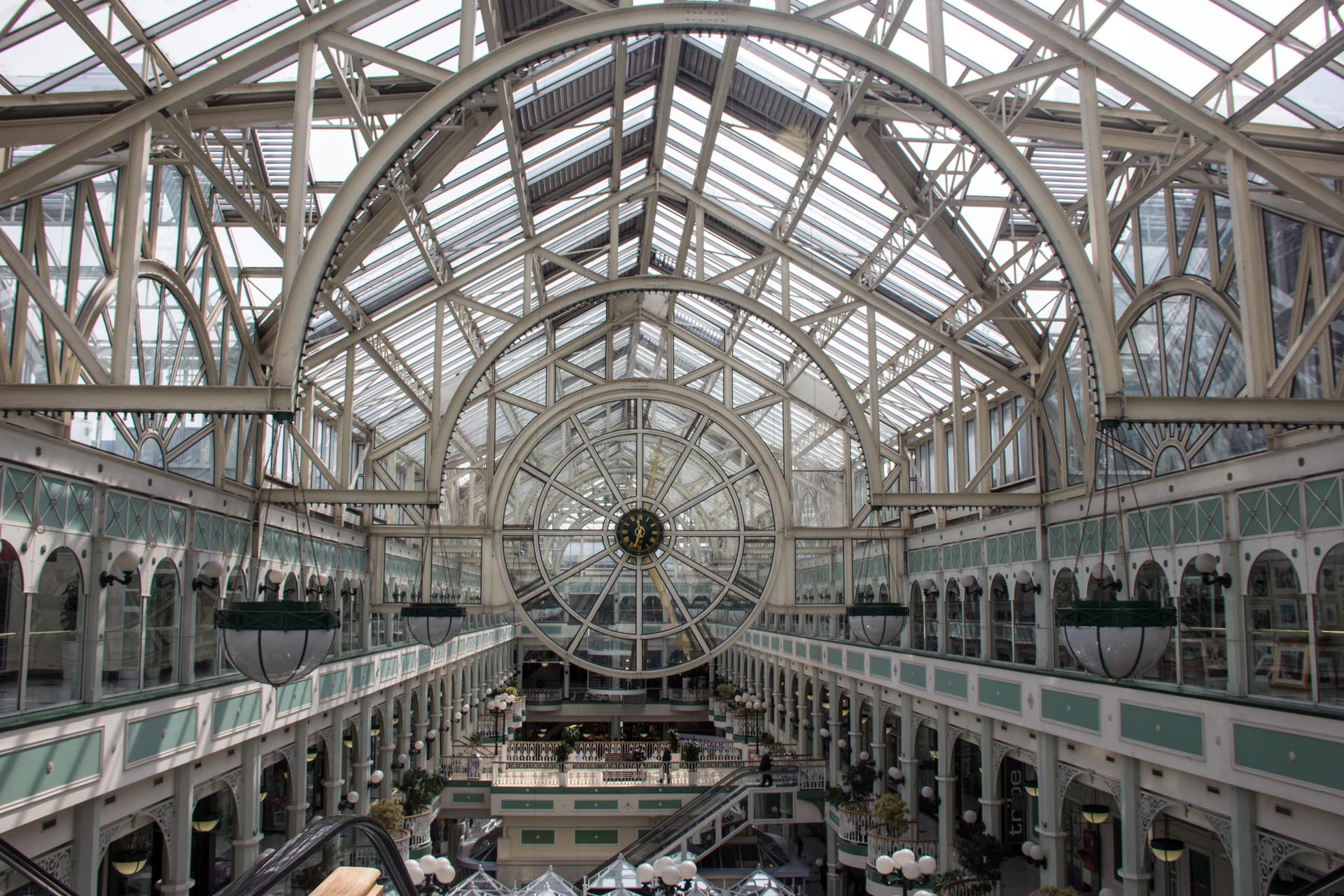 We were in Ireland for four days, three of which we spent in Dublin. The above is a from a shopping center we found. I kind of really wanted to know what it would be like inside there when it was raining, but we had dry weather nearly the whole time we were there. Here, I found a little craftsman shop that had things like handmade fisherman's sweaters, woolens, hats, and silver stuff. I bought an Irish-made scarf that was made from Irish sheep, and some yarn as well.
We were in Ireland for four days, three of which we spent in Dublin. The above is a from a shopping center we found. I kind of really wanted to know what it would be like inside there when it was raining, but we had dry weather nearly the whole time we were there. Here, I found a little craftsman shop that had things like handmade fisherman's sweaters, woolens, hats, and silver stuff. I bought an Irish-made scarf that was made from Irish sheep, and some yarn as well.
Nerd Alert:
For your knitting history fact of the day- knitting was and still is extremely popular in Ireland. Back when its main industry was fishing, (not a thing so much because of the EU) each family had a unique cable pattern that they would use to make sweaters and other woolens for the men going out to sea. If a fisherman fell overboard in a storm and drowned, his body was often identified by the sweater he was wearing. They're unique to the families, much like Scottish tartans.
We wandered a bit, and discovered that there are a lot of older churches in a very small area- only about a ten minute walk from our hostel. St. Patrick's Cathedral is the largest in Ireland, and it is apparently beautiful on the inside but we didn't go in. This one is still functional, which isn't true of a lot of the church buildings in Ireland.
We also wandered over to Trinity college, which was very beautiful and which was also entirely gated except for two entrances. We may have gotten a little tiny bit turned around in a hunt for Oscar Wilde's house- which turned out to be closed anyways, but we made it out alive. Trinity college seemed to have swallowed up his home- it's part of the building they use for computer science, and since we went on a weekend, we couldn't get in. This is one of those colleges where you're not allowed to walk on the grass, but everything is so very green and manicured, also. We sat for a bit looking at the green space, and compared it to Truman where someone is always playing frisbee somewhere.
At a few people's suggestion, we visited the Guinness Storehouse, which is basically a museum documenting the history and general goodness of Guinness, along with a brewery tour. I was glad I wasn't there with Dad, because he probably would have pitched a tent in the corner and decided to stay. One of the very cool things about the place is that it's in a building that used to be functional as part of the production of Guinness, so it's got these neat pipes, drains, valves, and duct work everywhere. Besides that, there was also an entire floor dedicated to the many ways in which Guinness has been advertised:
This, especially, was super cool:
There was also, of course, a tasting, and a lesson on the 'correct' way to drink Guinness, which involved standing up straight, raising your elbow parallel with the floor, toasting the founder, and feeling proud of the Guinness in order to get the full effect. I'm not the hugest fan of Guinness, but the whole thing was awesome: we both had a lot of fun. The Irish work it into everything, too- although I wasn't the hugest fan of the beer, I had a truly fantastic Irish Guinness stew in a pub, and I'm glad that Guinness exists so that that stew could happen.
On a side note, I'm reasonably sure that I belong in Ireland based on the fact that it is socially acceptable to have a potato dish with two different sides of als0-potatoes plus bread. It was like carb heaven, and if you know me, you know that I have an unparalleled love of potatoes. Why yes, I will have potato stew served over mashed potatoes with a side of fries. Do I get seconds with that?
 We were in Ireland for four days, one of which was spent on a bus tour to the Cliffs of Moher. The nice thing about this trip was that we stopped at a lot of scenic and historic places along the way, so we got to take pictures and learn about a lot of Irish culture. For example, there aren't a lot of castles or older buildings in general in Ireland, because the English tore a lot down when they decided they wanted Ireland: this castle is a rare exception. (Also, random wild swans?!)
We were in Ireland for four days, one of which was spent on a bus tour to the Cliffs of Moher. The nice thing about this trip was that we stopped at a lot of scenic and historic places along the way, so we got to take pictures and learn about a lot of Irish culture. For example, there aren't a lot of castles or older buildings in general in Ireland, because the English tore a lot down when they decided they wanted Ireland: this castle is a rare exception. (Also, random wild swans?!)
 It was a tiny bit rainy during the ride to the cliffs, if you hadn't noticed. This is a church across from the castle. Fortunately, the weather cleared up as we kept driving.
It was a tiny bit rainy during the ride to the cliffs, if you hadn't noticed. This is a church across from the castle. Fortunately, the weather cleared up as we kept driving.
 I spent basically the whole time taking pictures out the bus window- a lot of them turned out questionably, but that's how it goes. In total, I took 1456 photos on this trip. The Irish countryside is littered with rock structures- buildings like this, and of course the dry-stone walls that divide Ireland into sections so famously. It was really weird to see those walls, because nothing like that exists in the US. It's all green grassy countryside, but separated by low rock walls- whereas here, there are no walls, but you can tell the separations because of the different lawn treatments and crops that people grown. What we saw in Ireland was mostly grazing land, not cultivation. Irish sheep!
I spent basically the whole time taking pictures out the bus window- a lot of them turned out questionably, but that's how it goes. In total, I took 1456 photos on this trip. The Irish countryside is littered with rock structures- buildings like this, and of course the dry-stone walls that divide Ireland into sections so famously. It was really weird to see those walls, because nothing like that exists in the US. It's all green grassy countryside, but separated by low rock walls- whereas here, there are no walls, but you can tell the separations because of the different lawn treatments and crops that people grown. What we saw in Ireland was mostly grazing land, not cultivation. Irish sheep!
By the time we got to the cliffs, it was beautiful and outside again. By beautiful, I mean cloudy so that we pale folks don't risk third degree burns by stepping out of doors. Ireland understands my needs. Potatoes and clouds- it's not so hard.
In the movie Princess Bride, this was the filming location for the Cliffs of Insanity scene- time to rewatch that and recognize that! I'm pretty sure a lot of it was painted set rather than actual cliffs- and the top of the cliffs in that movie are sandy, whereas the tops of the actual ones are green and grassy- like the rest of Ireland.
When you get to the Cliffs, you do so from behind, and there are two options: turn right, and you get to the area where you can take picturesque pictures of the cliffs (reference: first two photos). Turn left, and you can walk all the way up to the edge of the cliff, if you are feeling adventurous or suicidal. We did that thing, of course. Maybe not toes-hanging-off kind of up to the edge, but at least within a few feet. The castle on a cliff photos are from the left side.
The water there was beautiful, too. It was this sort of teal color and was crashing up against the rocks at the base of the cliffs. We saw a boat while we were there, and resolved next time to see the cliffs that way: from the water looking up, instead of from the top looking down.
All of Ireland is beautiful! Every single solitary little bit. I loved it all.
On our way back to Dublin, we drove through The Burren, which is a country where there is not enough water to drown a man, wood enough to hang one, nor earth enough to bury him- according to Edmund Ludlow, who definitely knew what he was talking about. It's beautiful and desolate all at once. The whole place is basically rocks. It's on the coast of Ireland opposite Dublin, and the bit we visited was at the edge of Galway Bay. In the distance, we could see the Cliffs of Moher.
If you look closely, you can see the dry stone walls dividing up the countryside behind the remains of this church. Our last stop was an abbey from the 1100's:
There was a plaque: Corcomroe Abbey, St. Maria de Petra Fertilis. Foundation c. 1182, ascribed to Donal Mor O'Brien, King of Munster. In 1248 it was placed under the rule of the cistercian abbey of furness in Lancashire. During the many changes of ownership following its dissolution in 1564, the monks continued to tend the Abbey. Among the many interesting tombs and effigies in the chancel is one of a crowned figure, said to be that of Conor O'Brien, grandson of the founder, and a noted benefactor of the abbey.
The neat thing about this abbey- other than the obvious oldness and coolness of the architecture, of course, is that if you grow up in the area, you can still be buried there. The plaque mentions that the son of the founder was buried there (or at least he has a headstone there)- but I also saw headstones from as recent as 2012. You have to walk very carefully in order to avoid stepping on anyone's graves.
Excuse me while I nerd out some more about the architecture of this place...
Ireland was wonderful- we went out with some people we met in the hostel, one of whom was a printmaker from South Carolina who I am now friends with on Facebook- we spent all evening comparing his lithography work with mine (huge nerd alert, don't mind me...) The food was great, the people were interesting, and it was all a great experience as the first leg of our trip.
There were occasionally other people with oddly colored hair, but nobody stared too hard at the color of mine. A lot of women have dyed dark red/maroon colored hair, which I thought was an interesting choice considering the stereotypical fiery Irish redhead image. When we visit again, we would like to make more of an effort to see other parts of the country, now that we've seen the city.
There. You have the down low on Ireland, and the beginning of our Grand Adventure. Next stop, London- and an unexpected journey that technically came before Ireland, but which I am lumping in with the rest of England...


